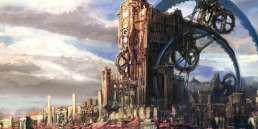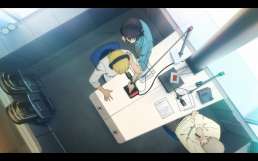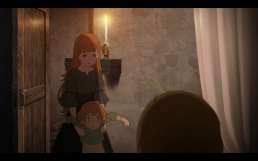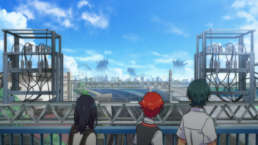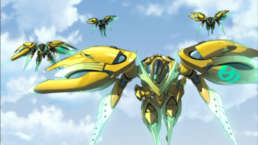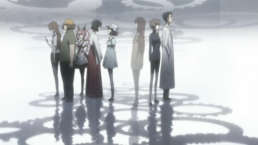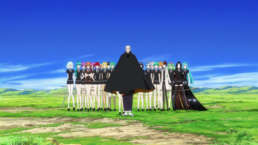Anime Suggestions For A Ravenclaw
Your Name.
Your Name is pretty easily my favorite anime movie. It’s fantastically beautiful in both art and animation, has great characters, has some really well integrated music, and has a great premise. In it, two high school students living very different lives, a boy in the big city of Tokyo, and a girl in rural small town Japan, end up swapping bodies a couple of times a week. The juxtaposition between their lives, and friends, and budgets, and, yes, even genders, is just so much fun. At times, they have to pretend to be each other just so as to not disrupt their normal lives. Eventually, they have to solve a common problem together… separately… acting in each other’s place.
I was blown away by this movie when I first saw it a few years back. If you watch nothing else on this list, watch this one.
Wave, Listen To Me!
This is a fun show I stumbled upon just a year or two ago. It follows a woman with an energetic and often comically disastrous personality as she tries to make the best of her day to day life. She has this ability to think and talk a mile a minute as she examines and comments on whatever situation she’s gotten herself in.
She is recorded one night in a bar while complaining about her ex boyfriend to an older man she doesn’t know. The next day, she hears her meandering, alcohol-fueled rant played over the local radio station! She rushes to the station to complain only for this older man, who turns out to be a radio station producer, to invite her to take a seat in the recording booth and apologize for her admittedly embarrassing rant on air! Which she does!
It turns out that this radio executive saw huge potential in her in that bar, and he recruits her to lead a late night radio show where she can use all her wit and improvisation and rapid fire thinking to tell stores and perform radio dramas and give silly life advice to callers based on their strange relationship questions.
Wave, Listen To Me! is a fantastic, fun, off-beat show that’s just a little different than anything else out there.
Time of Eve
This one is an interesting show set in the near modern day but where humanoid androids that serve as helpers and household assistants and the like are integrated into society. These androids are required by law to have a little holographic halo above their heads marking them as non-human, but there’s this one out of the way coffee shop called “Time of Eve” where the house rules allow androids to turn off that indicator. The rules also prohibit anyone from inquiring whether a person within the cafe is a human or not.
The show is centered around two high school boys who repeatedly visit the cafe and encounter a variety of different people with different personalities. Some of the people are obviously androids. Some of them are obviously not. And some of the peoples’ statuses are delightfully unclear. The interactions between our two main characters and the cafe’s patrons, each of whom get a fleshed out side story, are just wonderful. Sometimes the stories are endearing. Sometimes they are funny. And sometimes they are tragic. It’s such a great concept that is executed extremely well.
Oh, and you’ll want the movie version instead of the mini-series version. The movie version has all the content of the mini-series, and just a bit more.
Amanchu!
This is one of a class of anime that I enjoy where the anime is about a real world activity and really, really knows its subject matter. For instance, there’s various sports anime about baseball or tennis or whatever that get all the details right. Amanchu! is about scuba diving.
In it, we get a shy, introverted girl who has just moved to a new town and started attending a new high school. When she is forced to join a school club, she gets invited to join the scuba club by a wonky, energetic girl who soon becomes her best friend.
I was forced into taking one final elective in college and somehow lucked out at being able to take a sponsored scuba diving course. It was a huge delight to find this anime, because it gets almost everything right. From how the scuba systems work, to the buddy system you use to make sure you and your buddy are safe while diving, to the utter joy it is to be under water and able to breath.
Though based around scuba diving, there’s certainly plenty of fun slice of life content, too. Silly moments and friendship building and all that. But the process of our main character learning to scuba dive is the main draw here.
Maquia: When the Promised Flower Blooms
One last movie. Maquia: When the Promised Flower Blooms is a tale that is both epic in scope but very personal in execution. The movie is set in a magical medieval world where the magic of the world has naturally all but faded to nothing. Mezarte, the dominate kingdom of this tale, has long made use of fantastic flying dragons to maintain its power over its neighbors… but these immortal dragons its troops ride into battle are slowly dying off. In an effort to maintain an advantage over its rivals, Mezarte invades the distant territory of a peaceful people called the Iorph. The Iorph live incredibly long lives, you see, where they barely age at all even over the course of a human lifetime. Mezarte invades, abducts a handful of the Iorph intending to marry them off to produce immortal heirs, and kills the rest.
Our main character, Maquia, is an Iorph who manages to escape the slaughter of her people. As she flees, she stumbles upon a newborn human baby trapped within the arms of his murdered mother. Their wagon just happened to be between the invading army and Maquia’s people. Though Maquia hasn’t even reached full maturity herself, she adopts this human child as her own. The rest of the story is about this virtually immortal girl caring for her son as he ages. The relationship Maquia has with her son changes dramatically over the years as he goes from a baby, to a boy, to a teenager, and beyond. At times, their relationship is heartwarming, but sometimes it is heartbreaking. It all surrounds the question of how do you be a mother to someone when they age and you don’t.
The movie is magical and beautiful and sometimes tragic and sometimes thrilling. It is very well worth watching.
Review: Puella Magi Madoka Magica
In Short:
Released in 2011 by Shaft, Puella Magi Madoka Magica is a delightful take on the popular Magical Girl genre of anime. In it, young middle schooler Madoka Kaname and her best friend Sayaka Miki are approached by a cute magical creature who offers to make a contract with them. It will grant each of them any single wish they desire, but in exchange they must defend their city against monster-like Witches. Although it can be a dangerous job, love and friendship are shown to be the keys to winning the day.
Some of the Witches, and the distorted magical labyrinths in which they reside, can appear fairly frightening at first in contrast to the abounding level of wholesomeness the rest of the show puts forth.
Suggested Watch Minimum: 3 episodes. Although Madoka Magica is highly reflective of past Magical Girl shows, it’s not until the end of the third episode that you get a full feel for where it is going and what makes it different from its predecessors.
Full Review:
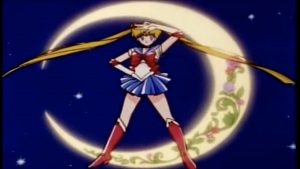 For myself and many others, the Magical Girl genre was how we were first introduced to anime. My first anime, whether or not I really knew it as anime back then, was the original 1992 English dub of Sailor Moon. In a Magical Girl anime, you typically have a clumsy or naive main character who comes in contact with a knowledgable mentor in the form of a cute magical animal. That mentor reveals that the main character is destined to have great hidden power or the ability to somehow fight evil if only they would unlock it. In a moment of crisis, the main character manages to transform in a flashy, highly detailed Henshin (Japanese for “transformation”) that usually gets repeated at least once per episode and uses their magical powers to defeat what is usually a monster or villain of the week. Making friends to fight along side and defeating evil are two of the most common aspects of Magical Girl shows.
For myself and many others, the Magical Girl genre was how we were first introduced to anime. My first anime, whether or not I really knew it as anime back then, was the original 1992 English dub of Sailor Moon. In a Magical Girl anime, you typically have a clumsy or naive main character who comes in contact with a knowledgable mentor in the form of a cute magical animal. That mentor reveals that the main character is destined to have great hidden power or the ability to somehow fight evil if only they would unlock it. In a moment of crisis, the main character manages to transform in a flashy, highly detailed Henshin (Japanese for “transformation”) that usually gets repeated at least once per episode and uses their magical powers to defeat what is usually a monster or villain of the week. Making friends to fight along side and defeating evil are two of the most common aspects of Magical Girl shows.
For Sailor Moon, the main character was Usagi Tsukino, a very clumsy and whiny middle school student who one day encounters Luna, a talking black cat. Luna reveals that Usagi is really Princess Serenity of the magical Moon Kingdom. With her true self revealed, Usagi is able to transform into the magical warrior Sailor Moon and fight to defend Earth against various evils along side other magical Sailor Scouts who soon become her friends.
 Released almost two decades later, Puella Magi Madoka Magica is a continuation of the Magical Girl genre first popularized by Sailor Moon. Our main hero, middle school student Madoka Kaname, is approached by the cute telepathic animal Kyubey who offers to make a contract with her. In exchange for helping to protect her city from “Witches”, hidden monsters who prey on ordinary people, Kyubey promises to grant Madoka any single wish she desires.
Released almost two decades later, Puella Magi Madoka Magica is a continuation of the Magical Girl genre first popularized by Sailor Moon. Our main hero, middle school student Madoka Kaname, is approached by the cute telepathic animal Kyubey who offers to make a contract with her. In exchange for helping to protect her city from “Witches”, hidden monsters who prey on ordinary people, Kyubey promises to grant Madoka any single wish she desires.
One of the things that makes Madoka Magica a worthwhile take on the genre, instead of a rehash of old ideas, is that Madoka does not become a magical girl by the end of the first episode as is so often the case with these type of shows. Instead, kind hearted Madoka and her friend Sayaka Miki, who has a strong sense of justice, hold back their wishes and team up with upper classman Mami Tomoe, their city’s most powerful Magical Girl, to see what it’s like to be a Magical Girl.
 For the first few episodes, Mami explains to the two friends how being a Magical Girl is a great thing in that you get to save people and make the city safe. But Mami also touches on the more dangerous side of become a Magical Girl. That it’s not always fun and games, and that if you are going to exchange a single wish for the responsibility for keeping the city safe, you need to make sure your wish is a good one.
For the first few episodes, Mami explains to the two friends how being a Magical Girl is a great thing in that you get to save people and make the city safe. But Mami also touches on the more dangerous side of become a Magical Girl. That it’s not always fun and games, and that if you are going to exchange a single wish for the responsibility for keeping the city safe, you need to make sure your wish is a good one.
As the show progresses we also meet Kyoko Sakura, a more rowdy Magical Girl whose carefree attitude butts heads with Sayaka’s sense of justice. And we meet Homura Akemi, a cold, aloof Magical Girl who, for some reason, wants to keep Madoka from making her wish with Kyubey.
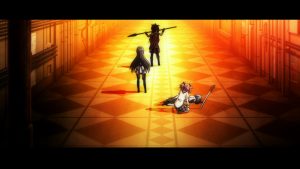 It’s these relationships and conflicts, all of which circle Madoka in one way or another, that really drive the show. In the end, it’s Madoka’s selfless sense of kindness that wins her friends over and saves the day. But along the way, there’s all sorts of great dialogue and outstanding character moments and some pretty interesting fights against the highly varied Witch monsters.
It’s these relationships and conflicts, all of which circle Madoka in one way or another, that really drive the show. In the end, it’s Madoka’s selfless sense of kindness that wins her friends over and saves the day. But along the way, there’s all sorts of great dialogue and outstanding character moments and some pretty interesting fights against the highly varied Witch monsters.
As a Magical Girl show, Madoka Magica wears its influences on its sleeve. From the cute episode opening and main theme, to the way Madoka wakes up in the morning, to the emphasis on the power of friendship, this show clearly knows the various tropes of the Magical Girl genre and hits on pretty much all of them. Even it’s main title graphic is highly reminiscent of past Magical Girl shows. But don’t let that fool you. Madoka Magica has a lot to offer even for someone who has seen past shows in the genre.
Graphics and Sound:
 Though it doesn’t have the sharpest, most on-point animation, Madoka Magica still does a good job of getting its characters and situations across to the viewer. Though details can sometimes be a bit rough, the show manages to put forth a striking scene when it needs to. In particular, the show’s use of mixed media and stop motion animation for the Witches Labyrinths is particularly interesting and gives the fights against the otherworldly creatures an extra bit of creepiness. Artistically, the vision is there, but whether it was intentional or not, the actual animation in Madoka Magica is a bit… sloppy. I’d highly encourage you to track down the Blu-ray version of the show since many scenes received a fresh coat of paint and extra background details that make things feel more fleshed out and lived in.
Though it doesn’t have the sharpest, most on-point animation, Madoka Magica still does a good job of getting its characters and situations across to the viewer. Though details can sometimes be a bit rough, the show manages to put forth a striking scene when it needs to. In particular, the show’s use of mixed media and stop motion animation for the Witches Labyrinths is particularly interesting and gives the fights against the otherworldly creatures an extra bit of creepiness. Artistically, the vision is there, but whether it was intentional or not, the actual animation in Madoka Magica is a bit… sloppy. I’d highly encourage you to track down the Blu-ray version of the show since many scenes received a fresh coat of paint and extra background details that make things feel more fleshed out and lived in.
Soundwise, Madoka Magica is excellent. The song that plays alongside the opening is bouncy and delightful. And the general episode music has a nice flair to it. One of my favorite tracks, Credens justitiam, which plays during Mami’s first transformation sequence is a great cross between a latin hymn and an upbeat personification of the power of friendship and justice. Other tracks within the show do a great job of setting the mood, as well. The music in Madoka Magica is provided by top anime composer Yuki Kajiura and is some of her most outstanding work yet recorded.
Subtitles vs English dub can go either way. Both are very well done with great voice actors giving life to their characters. It really comes down to your own preference as to which one you listen to.
All In All:
Madoka Magica is a refined take on the Magical Girl genre that easily distinguishes itself from past series. It’s universal themes of friendship and justice are paired with enough wrinkles to keep things fresh and interesting. And it’s soundtrack is epic and memorable.
That’s all to say, there’s a reason Puella Magi Madoka Magica is well regarded as one of anime’s top Magical Girl shows.
 The reason Puella Magi Madoka Magica is well regarded as one of anime’s top Magical Girl shows isn’t actually its delightfulness or homages to the past. Instead, it owes much of its fame to much darker things. (If you haven’t watched up through episode 3 yet, stop and go do that before reading further.)
The reason Puella Magi Madoka Magica is well regarded as one of anime’s top Magical Girl shows isn’t actually its delightfulness or homages to the past. Instead, it owes much of its fame to much darker things. (If you haven’t watched up through episode 3 yet, stop and go do that before reading further.)
Fans of the Magical Girl genre will already be feeling that things aren’t quite right throughout the first three episodes. The emphasis on the tension of choosing a good wish. The warnings Mami gives about protecting the city as a Magical Girl not being fun. The feeling of impending doom that rises any time Homura appears. It all points to something being off the norms for the genre…
…and then at the end of episode 3, Mami is unceremoniously killed and eaten by a Witch she thought she had defeated!
 The shock that reverberated through the anime community by the end of the third episode is almost the stuff of legends. And, it’s something many of us who love the show try to preserve for newcomers as best we can. Going in thinking Madoka Magica is very nearly a typical, upbeat Magical Girl show only to slam into the episode 3 twist is something I’ve led friends into multiple times. And most of them loved it.
The shock that reverberated through the anime community by the end of the third episode is almost the stuff of legends. And, it’s something many of us who love the show try to preserve for newcomers as best we can. Going in thinking Madoka Magica is very nearly a typical, upbeat Magical Girl show only to slam into the episode 3 twist is something I’ve led friends into multiple times. And most of them loved it.
What at first seemed to be a delightful if somewhat out of the ordinary take on the Magical Girl formula is suddenly transformed into someone else entirely. Something darker. Something even more interesting. From episode 4 on, Madoka Magica concerns itself with what drives people to be Magical Girls, the perils of exchanging a single wish for a dangerous, unending responsibility, and what happens if your cute magical mascot is not the innocent benevolent creature it usually is in these kinds of shows.
In reality, Puella Magi Madoka Magica has two main strengths: Its characters, and the horrifyingly cruel situation they are put in by their supposed mentor and helper Kyubey.
 In most Magical Girl shows, the small magical mascot animals that first grants the girls their powers become one of the girls’ closest friends. They stay with their appointed girl during their daily routine. They are invisible to others giving the girl someone to talk to about the challenges of being a Magical Girl. And they are caring and highly protective of their Magical Girls, often going so far as to defend their charge as best they can if the going gets rough. Kyubey fulfills all of those aspects… except the last ones. Instead of caring about the Magical Girls it makes a contract with, Kyubey is at best indifferent to their fates. In reality, Kyubey actively leads the girls to disaster through both its actions and inactions.
In most Magical Girl shows, the small magical mascot animals that first grants the girls their powers become one of the girls’ closest friends. They stay with their appointed girl during their daily routine. They are invisible to others giving the girl someone to talk to about the challenges of being a Magical Girl. And they are caring and highly protective of their Magical Girls, often going so far as to defend their charge as best they can if the going gets rough. Kyubey fulfills all of those aspects… except the last ones. Instead of caring about the Magical Girls it makes a contract with, Kyubey is at best indifferent to their fates. In reality, Kyubey actively leads the girls to disaster through both its actions and inactions.
Mami Tomoe’s death early on is the first big twist of the show. It is a harsh wakeup call telling you that Madoka Magica won’t be like other, more wholesome Magical Girl shows. But, it’s not the last surprise the show has in store. Instead of Madoka Kaname becoming a Magical Girl and using the power of friendship and love to defeat evil, Puella Magi Madoka Magica is actually about preventing Madoka from making her contract with Kyubey in order to try and save her from the grotesque, horrifying fate that, by design, awaits all Magical Girls.
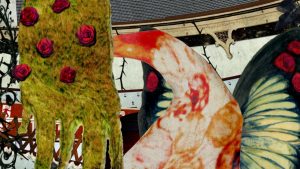 You see, Kyubey is actually a member of an alien race that call themselves Incubators. They are logical and emotionless and something of a hive mind to the point that they see human individuality and emotion as a sickness. They probably wouldn’t deal with us at all except they have a higher purpose. It’s their goal to save the universe from the restless force of entropy by harvesting an unending supply of energy from the Magical Girls that they create.
You see, Kyubey is actually a member of an alien race that call themselves Incubators. They are logical and emotionless and something of a hive mind to the point that they see human individuality and emotion as a sickness. They probably wouldn’t deal with us at all except they have a higher purpose. It’s their goal to save the universe from the restless force of entropy by harvesting an unending supply of energy from the Magical Girls that they create.
It turns out that the Witches that Mami and all other previous Magical Girls have been fighting have actually been the twisted forms of past Magical Girls who gave in to and were driven mad by their despair. Kyubey collects the energy generated by the transition from hope to despair without really caring about what it’s doing to the girls it makes a contract with.
 With that big reveal later in the series, suddenly all the efforts that Homura Akemi has taken to try and prevent Madoka from becoming a Magical Girl begin to make sense. Instead of a cold, uncaring person, Homura is shown to have become a Magical Girl expressly to save Madoka from her fate no matter how many tries it takes. Each time Homura fails, she travels back in time to try again and again and again. By the time the show starts, Homura has been stuck in this weeks long loop for over a hundred cycles. Her harsh, aloof attitude isn’t because she is uncaring, its because she cares so much that she has already exhausted every kinder, gentler approach to saving Madoka!
With that big reveal later in the series, suddenly all the efforts that Homura Akemi has taken to try and prevent Madoka from becoming a Magical Girl begin to make sense. Instead of a cold, uncaring person, Homura is shown to have become a Magical Girl expressly to save Madoka from her fate no matter how many tries it takes. Each time Homura fails, she travels back in time to try again and again and again. By the time the show starts, Homura has been stuck in this weeks long loop for over a hundred cycles. Her harsh, aloof attitude isn’t because she is uncaring, its because she cares so much that she has already exhausted every kinder, gentler approach to saving Madoka!
Along with Homura’s unending task are the tragic stories of Sayaka and Kyoko. The way these two first clash and later gain some sense of understanding of each other fleshes out the show so much. Sayaka’s initial sense of justice is understandably dashed when she finds out that she’s just being manipulated as a tool for a greater purpose. And, oddly enough, it’s the somewhat mean spirited, carefree, anything goes Kyoko that tries the hardest to save Sayaka from her downward spiral into despair.
 One of my favorite things about Madoka Magica is that its turn from delightful to cruelly tragic was all planned from before the beginning. All the teasers and trailers released for the series before it aired showed your typical candy-coated Magical Girl series. The initial ending theme for the first two episodes is light and happy only for the ending to be swapped out for a dark and ominous sequence by the third episode. Once you get far enough in to the show, even the lyrics to the opening song take on a new, darker meaning. Astonishingly, the production actually went so far as to hide the involvement of its co-creator and writer Gen Urobuchi from audiences since he was well known for going dark with his past works.
One of my favorite things about Madoka Magica is that its turn from delightful to cruelly tragic was all planned from before the beginning. All the teasers and trailers released for the series before it aired showed your typical candy-coated Magical Girl series. The initial ending theme for the first two episodes is light and happy only for the ending to be swapped out for a dark and ominous sequence by the third episode. Once you get far enough in to the show, even the lyrics to the opening song take on a new, darker meaning. Astonishingly, the production actually went so far as to hide the involvement of its co-creator and writer Gen Urobuchi from audiences since he was well known for going dark with his past works.
This purposeful deception on the part of the show’s creators, combined with the legitimately awesome story and characters are the real reason that Puella Magi Madoka Magica is held up as one of the best of the Magical Girl genre. This is one of those shows that doesn’t waste a moment. Every episode matters. Every action the characters take is important. But, maybe the best thing that the show does is that after all the grief and suffering it puts its characters through, it still remembers what it means to be a true, ideal version of a Magical Girl. It’s right there in the title. Magical Girl Madoka Magica. It turns out that the show wasn’t all one big elaborate lie. It just takes its sweet, delicious time building up to the things it initially promised. By the end of the series, Madoka finally makes her wish with Kyubey and becomes a Magical Girl. With the full knowledge of all the terrible things that came before, Madoka is able to make a perfect wish and embody the true spirit of a classic Magical Girl in breathtaking fashion.
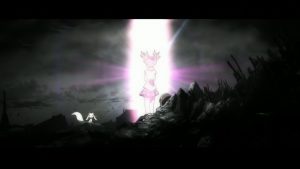 It’s this great moment where the series loops back on itself. After having shown just how horrible it is to trick young girls into fighting and dying and giving in to despair, the series is able to show us that the power of love and friendship and selflessness can win the day. The writing and pacing skills it took to pull that off along with a major time travel plot and along with multiple big, jaw dropping twists is truly remarkable. Because of all that, I’m of the opinion that Puella Magi Madoka Magica has one of the best stories and perhaps the best, most well supported, most perfect ending of any anime out there…
It’s this great moment where the series loops back on itself. After having shown just how horrible it is to trick young girls into fighting and dying and giving in to despair, the series is able to show us that the power of love and friendship and selflessness can win the day. The writing and pacing skills it took to pull that off along with a major time travel plot and along with multiple big, jaw dropping twists is truly remarkable. Because of all that, I’m of the opinion that Puella Magi Madoka Magica has one of the best stories and perhaps the best, most well supported, most perfect ending of any anime out there…
…which is gonna make things a bit awkward when we talk about the follow up movie, Rebellion.
Review: Spice and Wolf Anime
In Short:
Spice and Wolf is a 2 season, 24 episode anime from 2008 that is adapted from a long running series of light novels and manga. It tells the story of traveling merchant Kraft Lawrence and his companion Holo, a haughty yet clever wolf goddess who travels along side him in human form. In addition to bushels of downright excellent banter between its two leads, Spice and Wolf puts medieval economics front and center throughout its four main story arcs in a way that, astonishingly, remains interesting and tension filled right to the very end.
Though Spice and Wolf’s art is never bad, it is fairly modest compared to most shows I recommend. Come for the great leads and interesting economics, not flashy scenes or outstanding effects. This is also an anime that, unfortunately, ends on a somewhat of a lesser arc and an abrupt cliffhanger. On the bright side, the light novel series and manga have long since been complete and are readily available in both Japanese and English, so the story can continue if you wish it to.
Suggested Watch Minimum: 2 episodes. One of Spice and Wolf’s most notable aspects, its banter between its two lead characters, doesn’t really begin in earnest until its second episode. I also think Lawrence and Holo’s conversation about wolves is worth seeing before you make a decision.
Full Review:
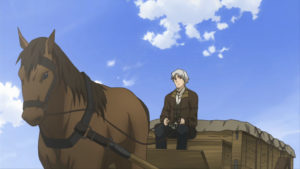 Spice and Wolf centers chiefly around Kraft Lawrence, an adult merchant in his prime who travels from town to town buying and selling a variety of wares in order to earn a living. Lawrence is an excellent business man and has a keen sense for making profitable deals, but he is also kind and personable, which tends to earn him the favor of most people he does business with.
Spice and Wolf centers chiefly around Kraft Lawrence, an adult merchant in his prime who travels from town to town buying and selling a variety of wares in order to earn a living. Lawrence is an excellent business man and has a keen sense for making profitable deals, but he is also kind and personable, which tends to earn him the favor of most people he does business with.
At the beginning of the series, Lawrence stops to trade with the wheat producing town of Pasloe just as it is finishing its harvest. He gets to watch as they carry out one of their harvest traditions where the person who cuts the last stalk of wheat puts on a mask and pretends to be the ancient wolf goddess Holo. This goddess was said to have made a deal with the town many generations ago whereby she would grant them bountiful harvests in exchange for their patronage. In more recent times, modern farming tools and techniques have largely seen Holo forgotten, though the town still performs a few last traditions in her honor.
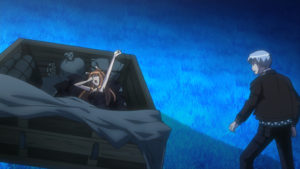 Lawrence feels an odd bump from the rear of his cart just as those last stalks of wheat are cut, but he quickly forgets about it as he interacts with the friendly residents. That night, however, on the road from Pasloe to the next town, Lawrence discovers what appears to be a young teenage girl sleeping naked in the back of his covered cart. When he wakes her he finds that she has the ears and furry tail of a wolf! This girl claims that she, in fact, is Holo the Wise Wolf and upon Lawrence’s insistence, she is able to prove it in dramatic and terrifying fashion!
Lawrence feels an odd bump from the rear of his cart just as those last stalks of wheat are cut, but he quickly forgets about it as he interacts with the friendly residents. That night, however, on the road from Pasloe to the next town, Lawrence discovers what appears to be a young teenage girl sleeping naked in the back of his covered cart. When he wakes her he finds that she has the ears and furry tail of a wolf! This girl claims that she, in fact, is Holo the Wise Wolf and upon Lawrence’s insistence, she is able to prove it in dramatic and terrifying fashion!
With the villagers no longer really upholding their end of their promise, Holo has decided it is time for her to move on from the town. She request that Lawrence allow her to travel with him as she makes her way back to her home in the north. What follows is the adventures of these two as they become traveling companions, business partners, friends, and perhaps something more.
 The relationship and banter between Lawrence and Holo is one of Spice and Wolf’s two main draws. While Lawrence is very adept at trade, he is a fairly straight-laced individual and often finds himself teased by the sometimes haughty, sometimes playful Holo. At the same time, Holo, who is some several hundred years old despite her youthful appearance, finds she has a lot to learn from the peddler she has decided to travel with.
The relationship and banter between Lawrence and Holo is one of Spice and Wolf’s two main draws. While Lawrence is very adept at trade, he is a fairly straight-laced individual and often finds himself teased by the sometimes haughty, sometimes playful Holo. At the same time, Holo, who is some several hundred years old despite her youthful appearance, finds she has a lot to learn from the peddler she has decided to travel with.
The range of topics and emotions the two engage each other with is fairly extensive, but more than that, it’s just so well done. They easily slip between discussing the practicalities of their plans in the next town, to goading each other with clever wordplay, to, at times, being put out or even hurt by one another in unexpected ways. It’s a little hard to describe, but despite one of the two being an immortal wolf goddess with a high opinion of herself, their conversations always have a feeling of reality and subtly to them that you don’t often get in even the best anime.
 It actually took me a good two or three episodes to really understand Holo’s frequent teasing of Lawrence, but what’s great about it is that the same holds true for Lawrence within the show. At first, he is often cut short by Holo’s proud nature and the little verbal traps she playfully lays out for him, but as time goes on, he begins to learn what flatters her, what angers her, and, perhaps most importantly, how best to tease her back.
It actually took me a good two or three episodes to really understand Holo’s frequent teasing of Lawrence, but what’s great about it is that the same holds true for Lawrence within the show. At first, he is often cut short by Holo’s proud nature and the little verbal traps she playfully lays out for him, but as time goes on, he begins to learn what flatters her, what angers her, and, perhaps most importantly, how best to tease her back.
And for Holo’s part, she never claims any real amount of power or authority as a goddess, in her words she simply is who she is, and she and Lawrence are mostly equals in their relationship, but, over time, she learns to put her faith in Lawrence’s business sense and supports him as best she can. There’s also a slowly developing romantic tension between Holo and Lawrence that eventually sees them on largely the same page by the end of the series.
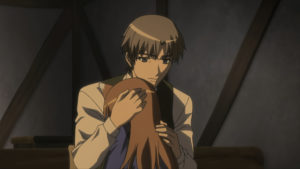 This progression between the two of them, from having a simple business arrangement to wanting to travel together above even their most deeply held dreams, plays out over the course of the show and just adds further to what makes them top tier characters.
This progression between the two of them, from having a simple business arrangement to wanting to travel together above even their most deeply held dreams, plays out over the course of the show and just adds further to what makes them top tier characters.
As the show progresses, we follow Lawrence and Holo through four main story arcs. Each one places a different challenge before the pair that test both their business sense and their growing feelings for each other. A lot of the time, the two have to work together to keep Holo’s true identity a secret. If the ever present church were to find out she is a pagan goddess, they would likely try to exorcise her or kill her in the name of the one true god. Holo poses as everything from Lawrence’s quiet business partner to his badly burned young wife so she can keep her wolf ears and tail hidden beneath her cloak. While keeping Holo’s identity a secret doesn’t play as large a role as the focus on finance and trade, it does come up from time to time in some interesting ways.
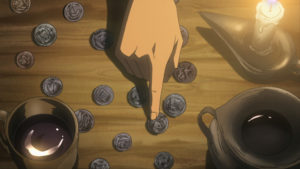 Spice and Wolf’s other core draw is its fascinating dedication to exploring medieval business and trade. Lawrence travels constantly from town to town trading one type of good, say furs, for another, such as apples. Though he almost always treats his clients with graciousness and respect, Lawrence does look to make the largest honest profit he can so as to one day fulfill a far off dream.
Spice and Wolf’s other core draw is its fascinating dedication to exploring medieval business and trade. Lawrence travels constantly from town to town trading one type of good, say furs, for another, such as apples. Though he almost always treats his clients with graciousness and respect, Lawrence does look to make the largest honest profit he can so as to one day fulfill a far off dream.
But now, with Holo at his side, Lawrence finds he has a business partner who is clever, thanks to her incredibly long life and innate resourcefulness, but who, because she had only dwelt near Pasloe for many generations, is also somewhat naive to realities of business dealings in the modern medieval world. This gives Lawrence the chance to explain things like the different worths of various silver coins and the reasons behind those differing values, or, how traveling merchants group together in guilds to protect and enhance each other’s good name. Though Holo may not understand a concept at first, she is often wise enough and quick-witted enough to catch on quickly. And, as she learns and explains new concepts to herself, we get to learn right along with her.
That I often think back to this anime when I hear about the real world valuations of currency, or import tariffs, or short selling stock, or trade negotiations is a credit to just how well Spice and Wolf handles the economic sides of its stories.
Graphics & Sound:
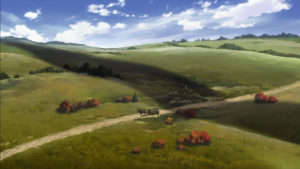 As noted above, Spice and Wolf’s art and animation are, perhaps, the least of its draws. It has great backgrounds, great character designs, and doesn’t cheap out anywhere in particular. There’s just something with the direction in general and action scenes in particular that lack the fluidity and movement you might see in other anime. Still, the show does have good direction in general and some great shots of its cities that do a good job showing off their layout and scale.
As noted above, Spice and Wolf’s art and animation are, perhaps, the least of its draws. It has great backgrounds, great character designs, and doesn’t cheap out anywhere in particular. There’s just something with the direction in general and action scenes in particular that lack the fluidity and movement you might see in other anime. Still, the show does have good direction in general and some great shots of its cities that do a good job showing off their layout and scale.
As for sound and music, I have no complaints. The opening songs of each season are wonderful. They both have this sort of sad comfort and coziness which is very appealing. Its two closings are a good bit more playful which works great most times, though I think there might be a couple of instance where we cut from heavy tension to happy, upbeat engrish. While a bit jarring, it’s certainly not the worst offender I’ve ever seen, so I’ll give it a pass for its rare minor musical sins.
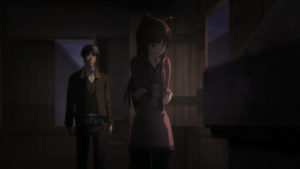 Finally, it takes good voice actors to pull off the wide ranging exchanges we get from Lawrence and Holo. Holo, in particular, can switch from feisty, to drunk, to introspective, to lonely, to appreciative all within the span of a single scene, and both her Japanese and English voice actresses pull off her various moods with aplomb! If you’re looking for a killer, best of anime performance, stick around until season 2 episode 3 where Japanese actress Ami Koshimizu kills it as Holo.
Finally, it takes good voice actors to pull off the wide ranging exchanges we get from Lawrence and Holo. Holo, in particular, can switch from feisty, to drunk, to introspective, to lonely, to appreciative all within the span of a single scene, and both her Japanese and English voice actresses pull off her various moods with aplomb! If you’re looking for a killer, best of anime performance, stick around until season 2 episode 3 where Japanese actress Ami Koshimizu kills it as Holo.
Lawrence is more subdued, most times, but he too goes through his fair share of emotions. If anything, we know that J. Michael Tatum, Lawrence’s English voice actor, has far and away more than enough range to pull off Lawrence thanks to his energetic, best of the best performance as Okabe Rintaro in Steins;Gate. Lawrence’s Japanese voice actor is pretty well regarded, as well, having started in a decent number of high profile roles. So, no matter how you watch it, Spice and Wolf is just a delight to listen to.
All In All:
Spice and Wolf somehow manages to combine great characters and conversations with explorations of medieval trade in a way that’s actually interesting and engaging. The relationship between Lawrence and Holo is very well regarded by anime veterans for good reason, and you don’t have to try hard at all to find someone who will jokingly claim that this anime helped them get through their economics classes.
 There are many, many good interactions between Lawrence and Holo throughout the series, but one of my favorite early ones is the conversation about wolves I mentioned at the first of this review. We get to see how Holo enjoys teasing Lawrence. She spins a little, playful folk tale about her kind not realizing that to Lawrence, a wolf attack is a deadly serious thing. We even see that Lawrence has lost traveling companions to wolves. That he’s seen them torn apart by them!
There are many, many good interactions between Lawrence and Holo throughout the series, but one of my favorite early ones is the conversation about wolves I mentioned at the first of this review. We get to see how Holo enjoys teasing Lawrence. She spins a little, playful folk tale about her kind not realizing that to Lawrence, a wolf attack is a deadly serious thing. We even see that Lawrence has lost traveling companions to wolves. That he’s seen them torn apart by them!
When Holo realizes what she’s done, she and Lawrence abruptly pause their banter for the entire time it takes them to pass through a village. For two companions that chat almost constantly, this long moment of tense silence is very powerful. When they emerge back into the countryside, Holo does the right thing and apologizes. It’s one of the first times that we see Holo as something more than a haughty, teasing goddess, and get to view her as a real person who can make mistakes.
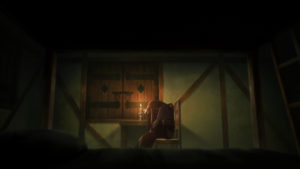 Though Holo is typically quite feisty, pay attention to the times when she isn’t. Her sense of loneliness, isolation, and the way she worries about her future even though she is effectively immortal are some of the things that elevate her to being one of my favorite characters in all of anime.
Though Holo is typically quite feisty, pay attention to the times when she isn’t. Her sense of loneliness, isolation, and the way she worries about her future even though she is effectively immortal are some of the things that elevate her to being one of my favorite characters in all of anime.
I’ll leave it to you, dear reader, to evaluate Lawrence and Holo’s relationship further. But, before I go, I’ll leave you with an interesting recommendation for another anime. If it turns out you liked the economics lessons of Spice and Wolf, go give Maoyu a try. It’s certainly the lesser of these two shows, but it was made by some of the same people and has a very familiar art style and aesthetic. Though not connected plot or character wise, the show relates to Spice in Wolf in the way it shows how a small medieval village is able to grow into a thriving city through the use of improved tools and techniques. You get explanations of things like crop rotations and trade deals and so on in much the same way Lawrence explains currency valuation to Holo.
Maoyu’s underlying plot and attempted romance between its leads never engages as well as anything in Spice and Wolf, but it’s still worth a watch for its economics lessons alone.
Review: Kaguya-sama: Love Is War
In Short:
Kaguya-sama: Love Is War is a 2019 anime from the well known studio A-1 Pictures. In it, our two main characters, the President and Vice President of their prestigious academy’s student council, play hilarious, ever escalating mind games with each other in an attempt to force the other to be the first one to declare their love.
This is a bombastic, over the top show with off the wall situations and zany, stylized animation. It’s certainly possible that some may not like its presentation or its largely disconnected episodic nature.
Suggested Watch Minimum: 1 episode. Although the show develops a bit more of an ongoing story in later episodes, the crazy situations and misunderstandings that make up much of the show are well represented in the first episode.
Full Review:
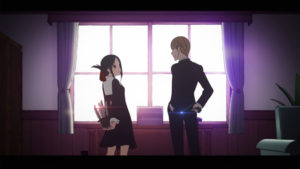 Love Is War’s inventive animation, wacky sense of humor, and crazy, bite-sized stories pulled me in almost immediately. We chiefly follow two main characters: Miyuki Shirogane, a smart, well-mannered, but financially poor high schooler who is the student council president of Shuchiin Academy. Opposite him is its student council vice president, Kaguya Shinomiya, who is the polite, clever, but heavily sheltered daughter of one of the Japan’s largest multi-corporation conglomerates.
Love Is War’s inventive animation, wacky sense of humor, and crazy, bite-sized stories pulled me in almost immediately. We chiefly follow two main characters: Miyuki Shirogane, a smart, well-mannered, but financially poor high schooler who is the student council president of Shuchiin Academy. Opposite him is its student council vice president, Kaguya Shinomiya, who is the polite, clever, but heavily sheltered daughter of one of the Japan’s largest multi-corporation conglomerates.
These two are crazy for each other, but there’s a problem: They both believe that being the first to admit their love will make them subservient to the other. In order to prevent that, the two keep their feelings a closely guarded secret from each other even as they spend much of their school days together in the large student council offices. Since neither one wants to admit their love, they engage each other in outwardly calm and subtle but inwardly dramatic and over the top mind games where they try and force the other to admit the feelings they are sure are there just beneath the surface. Seeing as our two main characters come from vastly different background, their attempts to force the other’s declaration of love vary in fun ways.
 Kaguya Shinomiya comes from the massively wealth and powerful Shinomiya family, so her tactics tend to be based on her limitless wealth and power… but she’s also massively sheltered so she tends to devise absurdly complex schemes only to be foiled by her own shyness or naivety. Her biggest fear is giving up her high standards just because she’s fallen for someone. Her most endearing quality is the way she sometimes freezes up when her plans go too right too quickly.
Kaguya Shinomiya comes from the massively wealth and powerful Shinomiya family, so her tactics tend to be based on her limitless wealth and power… but she’s also massively sheltered so she tends to devise absurdly complex schemes only to be foiled by her own shyness or naivety. Her biggest fear is giving up her high standards just because she’s fallen for someone. Her most endearing quality is the way she sometimes freezes up when her plans go too right too quickly.
 Miyuki Shirogane, on the other hand, comes from far more modest means. He only made it to the academy because of his impressive grades, not his family’s wealth, so his tactics tend to be simpler and more direct, but often fail in amusing ways. His biggest fear is doing something embarrassing and having Kaguya dismissively say to him: “How cute.” His most endearing quality is his selfless need to help others.
Miyuki Shirogane, on the other hand, comes from far more modest means. He only made it to the academy because of his impressive grades, not his family’s wealth, so his tactics tend to be simpler and more direct, but often fail in amusing ways. His biggest fear is doing something embarrassing and having Kaguya dismissively say to him: “How cute.” His most endearing quality is his selfless need to help others.
Playing a crazy, unintentional foil to our two fantastic leads is pink-haired Chika Fujiwara who is so delightful that she is very nearly the star of the show. She is so simple minded and excitable that she tends to be the hand grenade who accidentally derails the two main characters’ carefully laid plans time and time again.
 There’s also Ai Hayasaka, Kaguya’s assistant, who realizes that Kaguya and Miyuki are secretly in love and who tries to force them together in amusing ways. And there’s Yū Ishigami, an emo geek/gamer in charge of student council finance who tends to unintentionally get on the ladies’ bad side. He’ll often skulk out of the room saying “I think I’ll go home now and die…” to which someone inevitably says “ok… but please don’t actually die.” A couple of new characters are added to the student council in season two and do a great job at keeping things interesting.
There’s also Ai Hayasaka, Kaguya’s assistant, who realizes that Kaguya and Miyuki are secretly in love and who tries to force them together in amusing ways. And there’s Yū Ishigami, an emo geek/gamer in charge of student council finance who tends to unintentionally get on the ladies’ bad side. He’ll often skulk out of the room saying “I think I’ll go home now and die…” to which someone inevitably says “ok… but please don’t actually die.” A couple of new characters are added to the student council in season two and do a great job at keeping things interesting.
Most episodes are spilt into three “battles” where one side or the other tries to carry out a scheme to force the other to confess their love. One character will play their hand only to have the other counter that play in some fashion only to have that counter countered. And so it goes. During all this, they exhibit frantic worrying at whether a plan will work and wide eyed shock as one of their foolproof plans is upended with nothing more than an unexpected word or action. At the end of each battle, the ever present narrator will declare one side the winner or loser, and the episode will move on to a new situation.
What kind of schemes, you ask? Here’s a small smattering of the many many little scenarios that play out over the course of the series:
- Kaguya arranges for Miyuki and herself to receive movie tickets to a romantic movie. The two enter into a battle of wits to see who can force the other to ask them to the movies.
- Kaguya, Miyuki, and Chika play a game where they have to trick each other into saying a word each of them doesn’t know but the others can see.
- Miyuki tries to give relationship advice to a fellow male student while Kaguya secretly listens in.
- Kaguya switches Miyuki’s coffee to decaf with unexpected results.
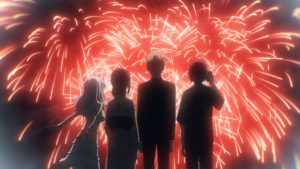 At first, the show seems like it’s not going anywhere. It’s massively fun and entertaining, to be sure, but the first few episodes are just one unrelated battle after another. But, pretty soon, you start to notice that later episodes connect to earlier ones. A plot slowly begins to form. This is not a narrative heavy show by any means, but by the end of the first season, you’ll find yourself rooting for both the main characters in ways you didn’t expect because of little plot points that have built up along the way.
At first, the show seems like it’s not going anywhere. It’s massively fun and entertaining, to be sure, but the first few episodes are just one unrelated battle after another. But, pretty soon, you start to notice that later episodes connect to earlier ones. A plot slowly begins to form. This is not a narrative heavy show by any means, but by the end of the first season, you’ll find yourself rooting for both the main characters in ways you didn’t expect because of little plot points that have built up along the way.
The second season has a bit more of a running plot, but it too has a lot of loosely connected witty one-off battles. It’s interesting to note, though, that the title changes in the second season from “Love Is War!” to “Love Is War?” The title change matches the slowly shifting objectives of the lead characters as they being to realize that, yes, the other is in love with them.
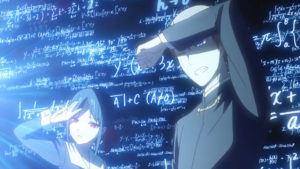 Animation wise, this is not exactly a powerhouse in a traditional sense. A lot of episodes take place in the familiar, large-ish student council room or in other reused parts of the academy. There’s a lot of minimally animated close ups and slow panning shots. But, that’s not to say the show cheaps out in any way. Love Is War goes to extraordinarily lengths to mix things up as its two leads dive deeper and deeper into their crazy plots. The show shifts to absurd charactatures, and complex moving backgrounds, and constantly changing over the top special effects as it visualizes each characters’ thought processes. The show’s art is totally absurd and off the wall, at times, but it totally works!
Animation wise, this is not exactly a powerhouse in a traditional sense. A lot of episodes take place in the familiar, large-ish student council room or in other reused parts of the academy. There’s a lot of minimally animated close ups and slow panning shots. But, that’s not to say the show cheaps out in any way. Love Is War goes to extraordinarily lengths to mix things up as its two leads dive deeper and deeper into their crazy plots. The show shifts to absurd charactatures, and complex moving backgrounds, and constantly changing over the top special effects as it visualizes each characters’ thought processes. The show’s art is totally absurd and off the wall, at times, but it totally works!
When talking about animation, I’ve also got to heap praise on the shows’ various openings and closings. The season one opening feels like something out of a James Bond film with lots of complex shots and interesting imagery of our two leads at war with each other. The second season opens with a fun, quickly told miniature story typical of the show’s longer battles. Both openings are set to some downright groovy soundtracks that you’ll find yourself humming long after you finish the show. The closings of the seasons are also well worth watching. 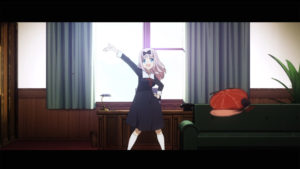 They are strange and fascinating in their own ways.
They are strange and fascinating in their own ways.
And then, there’s the one-off closing for episode 3 of the first season. Titled “Chika Dance”, it features about a minute of some of the most absurdly detailed character animation you’ve ever seen. This closing had the entire internet abuzz when it first debuted, and for good reason!
All In All:
This is an outstanding, goofy series that pokes fun at the absurdity of high school students who wish they could make the other declare their love but who are too smart for their own good. It’s delightful and good natured while being laugh out loud funny several times an episode. And, as the series progresses, it does gradually reveal that it actually has some heart tucked away somewhere between all the absurdity.
Review: SSSS.Gridman
In Short:
SSSS.Gridman is a 2018 anime by Studio Trigger that centers around four high school students living in a seemingly normal world, one of whom transforms into the building-sized, robot-looking hero known as Gridman in order to protect his city from equally large kaiju monsters. The show is packed full of great animation, terrific action, excellent characters, and stand out music, as well as a well told plot that has some nicely hidden depth.
Suggested Watch Minimum: 2 episodes. You need to see the full results of the first kaiju attack before making a decision on SSSS.Gridman.
Full Review:
SSSS.Gridman, for me, was an “eh, I might as well try it” kind of show. I’m not such a big fan of Godzilla, Power Rangers, or the numerous “giant-sized hero fights giant monsters who are very obviously guys in monster suits” type shows. They always felt too cheap and silly to me. SSSS.Gridman, though, knocked the formula clear out of the park, scoring a grand slam, a drop goal, and an extra point all at the same time. Yes, it’s that good!
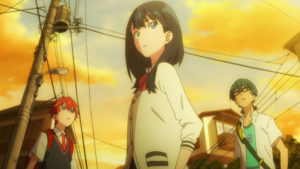 It’s a little hard to say much about SSSS.Gridman given that I tend to be a little more protective of first time viewers of shows I really like. At its core, the show is about four high school students: Hibiki Yūta – a normal student who wakes up one evening with amnesia, Utsumi Shō – something of a nerd and lover of old kaiju shows, and Rikka Takarada – a girl who would prefer a normal life and is shocked by what takes place around her. There’s also Akane Shinjō, who hates it when things don’t go her way.
It’s a little hard to say much about SSSS.Gridman given that I tend to be a little more protective of first time viewers of shows I really like. At its core, the show is about four high school students: Hibiki Yūta – a normal student who wakes up one evening with amnesia, Utsumi Shō – something of a nerd and lover of old kaiju shows, and Rikka Takarada – a girl who would prefer a normal life and is shocked by what takes place around her. There’s also Akane Shinjō, who hates it when things don’t go her way.
One day, kaiju start appearing in the city, and it’s up to Hibiki to merge with Gridman, some sort of high tech computer based guardian, in order to put a stop to them. Along the way, Gridman picks up new allies and enemies as the ongoing conflict escalates. As the show continues, we learn more about the why these monstrous kaiju are attacking the city, and who is sending them. The answers are interesting and character driven and go far beyond the typical “an evil villain did it.”
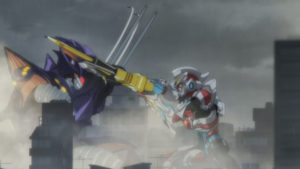 SSSS.Gridman features insane, highly detailed action sequences, great effects, wonderful character animation, and some high octane action music that lets the show kick ass every episode. The battle scenes have that same “these monsters are moving really fast but are also really big so they look slow and powerful” feel that Pacific Rim had a few years back. When Gridman appears, he typically lands in the street and the entire surrounding city shakes as cars and debris are thrown dozens of feet into the air. The attention to detail is just outstanding. And so is the combat. From massive energy beams to rocket accelerated punches, to classic kaiju throws, SSSS.Gridman delivers.
SSSS.Gridman features insane, highly detailed action sequences, great effects, wonderful character animation, and some high octane action music that lets the show kick ass every episode. The battle scenes have that same “these monsters are moving really fast but are also really big so they look slow and powerful” feel that Pacific Rim had a few years back. When Gridman appears, he typically lands in the street and the entire surrounding city shakes as cars and debris are thrown dozens of feet into the air. The attention to detail is just outstanding. And so is the combat. From massive energy beams to rocket accelerated punches, to classic kaiju throws, SSSS.Gridman delivers.
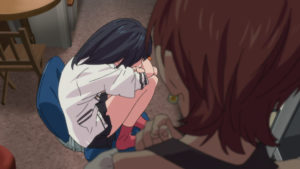 Gridman saves the city from the kaiju time and time again as our three friends try to figure out what’s causing it all. The things they learn are pretty shocking. Out of our three leads, I really enjoyed the realistic human emotions given to Rikka. The way she frets over her friends throughout the series, even to the point of inaction, felt very believable and very well done to me.
Gridman saves the city from the kaiju time and time again as our three friends try to figure out what’s causing it all. The things they learn are pretty shocking. Out of our three leads, I really enjoyed the realistic human emotions given to Rikka. The way she frets over her friends throughout the series, even to the point of inaction, felt very believable and very well done to me.
I’d be remiss if I didn’t specifically mention the music. It’s interesting in that SSSS.Gridman actually doesn’t use music that often, and when it does, it mainly uses its opening theme “Union” as Gridman’s upbeat battle song. And that’s kinda it. Most of the non-action scenes don’t have significant music backing them, but it works because the tension and dialogue keep things moving just fine on their own. But, wow, when the show does use music, it does so perfectly to further amp up the action.
All In All:
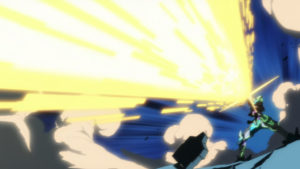 I’ve got no real wrap-up this time. I’m just here to say good things about SSSS.Gridman. Great art. Great animation. Great action. Great characters. Great plot. Great music. And some nicely hidden depth to its story and characters. Just go watch SSSS.Gridman, already.
I’ve got no real wrap-up this time. I’m just here to say good things about SSSS.Gridman. Great art. Great animation. Great action. Great characters. Great plot. Great music. And some nicely hidden depth to its story and characters. Just go watch SSSS.Gridman, already.
Oh, and be sure to watch until literally the very last second or you will miss out! You’ll also want to watch the official music video of “Union” by OxT for a final few scenes of closure after you finish the series.
I held off talking about the plot until this section because it is so tied up with the mental state of Akane Shinjō. The show takes some care to obscure her role in the story for the first episode, but from the second episode on it’s clear she is the driving force behind everything. And, as the story unfolds more and more, we find out that “everything” really does mean “everything.”
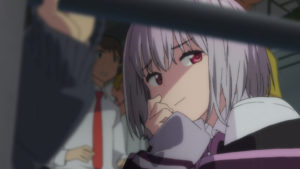 It turns out Akane is dreaming, and everything in her dream city is set up for her by her. The city layout. The school. Even all the people who populate the city. None of them are real. All of them are geared to the ideal world that Akane wishes she lived in. Including our three main characters. Even Akane is an idealized version of her true self in this dream world!
It turns out Akane is dreaming, and everything in her dream city is set up for her by her. The city layout. The school. Even all the people who populate the city. None of them are real. All of them are geared to the ideal world that Akane wishes she lived in. Including our three main characters. Even Akane is an idealized version of her true self in this dream world!
Take a closer look at Akane. In her dream world, she is a back row student with big breasts and oddly bleached hair who lives alone in a house packed with kaiju models and garbage bags. Despite not really ever doing anything other than sitting at her desk, she is easily the most popular girl in the entire school. Everyone wants to hang out with her all the time. They’re almost always gathered around her desk. Everything about Akane, her looks, her popularity, her carefree living conditions, they’re all made up and made perfect to one extent or another.
What does this say about the real world Akane? Does she not like her appearance? Does she wish she was more popular? Does she enjoy kaiju but has to keep her like of monster movies and models a secret? Maybe! But let’s keep going.
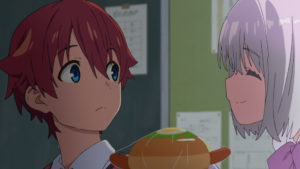 Think about Hibiki. Near the end of the series, Gridman says he was only able to take over Hibiki’s body because… and then something distracts Gridman and we don’t hear the reasoning!
Think about Hibiki. Near the end of the series, Gridman says he was only able to take over Hibiki’s body because… and then something distracts Gridman and we don’t hear the reasoning!
But, I think we can tease out what he was going to say. Right near the end of the series, in the final episode, Rikka and Utsumi again speculate on why Gridman choose Hibiki and we’re shown a very interesting scene. We see Akane at her desk surrounded by her many friends, but then there’s Hibiki sitting beside her, not paying her any attention. Instead, he’s looking towards Rikka at the front of the room. And they notice each other. There’s a spark between them! In Akane’s perfect world, a world where everyone was built to like her, the boy she sits beside took an unexpected interest in someone other than her!
During the series, we see that Akane’s creations can have free will. Hibiki, Utsumi, and Rikka reject her perfect dream worlds. Anti overcomes his programming and instead of fighting against Gridman he fights with him. I think maybe Hibiki was the first person, and at that point the only person in Akane’s entire city, to actively go against her designs. That’s pretty cool.
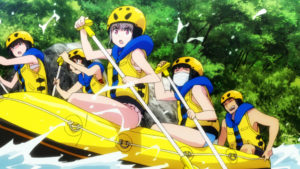 But, there’s another, super fascinating layer to that. We know Akane can’t control a whole world by herself based on what she said near the very end. Even creating a river rafting play space for a day trip takes her time and effort. So, it seems likely that she also didn’t hand design each and every person in her city or even in her classroom. Rather, the city, the classroom, and all the people in her dream world are copies or replicas of people and places she knows from the real world. Maybe Hibiki is a representation of a boy she likes in school? That could make sense. Akane clearly likes him in the dream world, and is attracted to him. It even takes her to the next to the last episode to physically attack him despite knowing that he’s the one constantly messing up her plans. She targeted and killed people with her kaiju for far less than that!
But, there’s another, super fascinating layer to that. We know Akane can’t control a whole world by herself based on what she said near the very end. Even creating a river rafting play space for a day trip takes her time and effort. So, it seems likely that she also didn’t hand design each and every person in her city or even in her classroom. Rather, the city, the classroom, and all the people in her dream world are copies or replicas of people and places she knows from the real world. Maybe Hibiki is a representation of a boy she likes in school? That could make sense. Akane clearly likes him in the dream world, and is attracted to him. It even takes her to the next to the last episode to physically attack him despite knowing that he’s the one constantly messing up her plans. She targeted and killed people with her kaiju for far less than that!
So then, what about Rikka? I think Rikka is a lot more interesting than she first appears and is more critical to the plot than is stated out loud. Think back to all the times Rikka and Akane interact. Think of how Akane singles Rikka out to be her friend when she has people fawning over her already. Take note of all the similarities between Akane and Rikka. For instance:
- In the dream world, Rikka and Akane live directly next door to each other, a coincidence Akane must have designed.
- They both hate walking to school when it’s hot out so they take the bus on hot sunny days.
- They dislike the group date with Arcadia for very nearly the exact same reasons.
- They don’t want to join a high school club and both would just rather go home at the end of the day.
- They excuse themselves from awkward situations in the same formal manner.
- They both dislike school festivals.
- They both are prone to getting depressed and curling in on themselves with their knees against their chests when they’re upset.
- And, this is the big one, Rikka in the dream world has the hair and build of Akane when she wakes up in the real world!
 Here’s what I think happened. Unlike Hibiki, Rikka isn’t a copy of a real world friend used to populate Akane’s dream world. No. She is, in actuality, Akane’s projection of her real world self!
Here’s what I think happened. Unlike Hibiki, Rikka isn’t a copy of a real world friend used to populate Akane’s dream world. No. She is, in actuality, Akane’s projection of her real world self!
To put it more simply: Rikka is Akane.
There are so many scenes where Akane and Rikka react the same, talk the same, and even move the same. I didn’t notice this the first time through, but watching the show again a second time, knowing that Rikka is Akane’s creation the entire time, it just jumped out at me how similar the two are.
 And that ties back in to Gridman and Hibiki in a fun way. Hibiki, the boy that Akane created, the one she choose to sit by in class, the one who should be drawn to her just like everyone else. He actually did like her. Did fall for her. He just fell for Rikka, the more real version of her. I think Akane subconsciously set up Hibiki to like her, but he saw through the fake version Akane choose for herself and ended up liking the more realistic version by mistake. And that little, unintentional defiance on Hikibi’s part gave Gridman his way in to help save Akane from herself. That’s pretty cool!
And that ties back in to Gridman and Hibiki in a fun way. Hibiki, the boy that Akane created, the one she choose to sit by in class, the one who should be drawn to her just like everyone else. He actually did like her. Did fall for her. He just fell for Rikka, the more real version of her. I think Akane subconsciously set up Hibiki to like her, but he saw through the fake version Akane choose for herself and ended up liking the more realistic version by mistake. And that little, unintentional defiance on Hikibi’s part gave Gridman his way in to help save Akane from herself. That’s pretty cool!
As for Utsumi? I wonder if he’s not a projection of Akane’s kaiju obsession in some way.
Let’s see… what else?
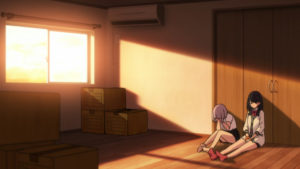 I really liked Akane’s choice to leave. Her friends convinced her that it’s no good being alone. That she needs to lean on and rely on the people around her. And so she does, but she also says that she’s done too many terrible things to her fictional world and that she needs to choose to leave it and go back to her real world. The first time around, I thought her choice was simply to vanish at the end. But no. It was a lot more deliberate than that! Look closer. She packed up her room. She cleaned up all the trash. She placed all her things into neat, tidy, sealed moving boxes. It was a very deliberate act on her part to go away. And when she does vanish, note that all her boxes leave with her while Rikka stays behind in that empty room in Akane’s empty house. It was a powerful moment, and also one that I think fully confirms that Akane’s dream world will continue on without her.
I really liked Akane’s choice to leave. Her friends convinced her that it’s no good being alone. That she needs to lean on and rely on the people around her. And so she does, but she also says that she’s done too many terrible things to her fictional world and that she needs to choose to leave it and go back to her real world. The first time around, I thought her choice was simply to vanish at the end. But no. It was a lot more deliberate than that! Look closer. She packed up her room. She cleaned up all the trash. She placed all her things into neat, tidy, sealed moving boxes. It was a very deliberate act on her part to go away. And when she does vanish, note that all her boxes leave with her while Rikka stays behind in that empty room in Akane’s empty house. It was a powerful moment, and also one that I think fully confirms that Akane’s dream world will continue on without her.
The last thing I’d like to note is the final thirty seconds of the series. The part where Akane wakes up in the real world. At first I saw it as a cop out. “It was all a dream!” is one of the worst turns a story can take. But here, the ending doesn’t take away from the story. It’s a continuation of it. It adds closure to it.
 Multiple times during the show, most notably during episode 9 where everyone was dreaming, Akane is told that she too needs to wake up from her dream. And she does! But the coolest part of that is, her story doesn’t end with the end of the show. Go watch the official music video of OxT’s “Union”. We see Akane wake up and go out to meet up with her friends, possibly to tag along with them on the way to school.
Multiple times during the show, most notably during episode 9 where everyone was dreaming, Akane is told that she too needs to wake up from her dream. And she does! But the coolest part of that is, her story doesn’t end with the end of the show. Go watch the official music video of OxT’s “Union”. We see Akane wake up and go out to meet up with her friends, possibly to tag along with them on the way to school.
I think the takeaway there is the real Akane had some sort of trouble at school. Perhaps boy trouble. She went home mad, depressed, angry. She had a dream where she ruled everything and could fix anything she didn’t like. During that dream, the alien Alexis Kerib invaded her mind and gave her the power to shape her world by making kaiju. She got so tied up in it and in her negative emotions that eventually she even saw killing as ok as long as it made her feel better. But then, Gridman came and together with some of the created inhabitants of Akane’s dream world, he managed to remind her that she had friends she could rely on. When she wakes up in the real world, she feels better about herself and the first thing she does is go track down and join up with her friends.
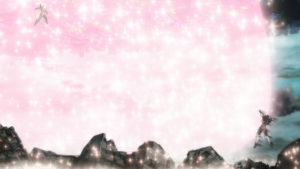 One last thing worth noting is an area I don’t have a ton of knowledge in but should be pointed out anyway. SSSS.Gridman is based on and may be even a direct continuation of the 1993 Japanese live action show “Gridman the Hyper Agent”. Many of the things that seem to come out of nowhere like the Fixer Beam or the kaiju girl who told Hibiki about Akane are directly related to the older series. I haven’t done anything so crazy as try to track down all the references, but just know that a lot of the unexplained didn’t just spring up from nowhere. They were probably things that happened a couple of decades ago that got a knowing mention in this new series.
One last thing worth noting is an area I don’t have a ton of knowledge in but should be pointed out anyway. SSSS.Gridman is based on and may be even a direct continuation of the 1993 Japanese live action show “Gridman the Hyper Agent”. Many of the things that seem to come out of nowhere like the Fixer Beam or the kaiju girl who told Hibiki about Akane are directly related to the older series. I haven’t done anything so crazy as try to track down all the references, but just know that a lot of the unexplained didn’t just spring up from nowhere. They were probably things that happened a couple of decades ago that got a knowing mention in this new series.
Review: Strain: Strategic Armored Infantry
In Short:
Strain: Strategic Armored Infantry is a 2006 sci-fi anime from Studio Fantasia that follows cadet Strain pilot Sara Werec as she pursues her older brother across the stars looking for answers after he betrays her. The show offers interesting takes on depression, determination, and mech-based space combat. It also makes novel use of the time dilation effects of faster than light travel as part of its core plot.
Though I enjoy the show and its themes a great deal, it is decidedly not in the top tier of anime. It simply does not reach any kind of “best of the best” status across plot, animation, sound, or music… though the battle theme is pretty good. There’s also an unfortunate fan service episode in episode 7 that can almost be entirely skipped.
Suggested Minimum Watch: 2 episodes. You need to see Sara before and after the attack on planet Grabera before making a decision on the series.
Full Review:
I first found Strain: Strategic Armored Infantry in my early days of anime. It was one of the first I watched during the earliest days of Funimation streaming, and it stuck with me all these years later.
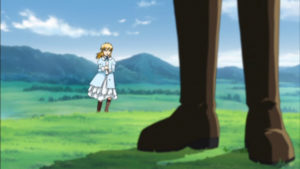 The story starts with Sara Werec, a young girl who faces the prospect of never seeing her beloved older brother again. You see, her brother, Ralph, is a Reasoner: a pilot trained to fly large, mech-like space fighters called Strains. Ralph is being deployed to the front lines of humanity’s long running civil war several light years away and due to the effects of time dilation caused by faster than light travel, this means young Sara will grow up, grow old, and die before Ralph is able to return. In order to again see her brother, Sara makes a choice to follow in his footsteps and become a Strain pilot herself.
The story starts with Sara Werec, a young girl who faces the prospect of never seeing her beloved older brother again. You see, her brother, Ralph, is a Reasoner: a pilot trained to fly large, mech-like space fighters called Strains. Ralph is being deployed to the front lines of humanity’s long running civil war several light years away and due to the effects of time dilation caused by faster than light travel, this means young Sara will grow up, grow old, and die before Ralph is able to return. In order to again see her brother, Sara makes a choice to follow in his footsteps and become a Strain pilot herself.
We catch up to Sara a few years later as she and her fellow cadet Reasoners are nearing graduation at their Strain pilot training academy. Sara, like her brother, has become one of the best of the best, and she can’t wait to head out to the front lines to finally meet up with him. Unfortunately, fate has other things in store for her. When Sara’s university on planet Grabera comes under attack by enemy forces, she and her friends board their Strains in order to push back the enemy. They do well at first, but then learn that Ralph and his advanced Strain are leading the enemy’s attack! After defeating nearby opposition, including Sara, Ralph breaks into a research facility to steal a strange girl being held there. He then departs leaving his battered younger sister behind traumatized and in need of answers.
 Having lost her ability to pilot a Strain due to her brother’s attacks, Sara’s quest should be over, but her need for answers won’t let her quit. She changes her name and reenlists in the military in secret as a pilot in the much slower rank and file Gambee mech squadrons. Though she is deeply frustrated and deeply traumatized, Sara continues after her brother no matter the risks or abuses she faces along the way.
Having lost her ability to pilot a Strain due to her brother’s attacks, Sara’s quest should be over, but her need for answers won’t let her quit. She changes her name and reenlists in the military in secret as a pilot in the much slower rank and file Gambee mech squadrons. Though she is deeply frustrated and deeply traumatized, Sara continues after her brother no matter the risks or abuses she faces along the way.
It’s Sara’s determination that really kept me with the show. She’s stuck piloting a machine that her Strain could run circles around and she has to keep her identity hidden unless she wants to face endless questions about her loyalty given the atrocities her brother committed. Perhaps even worse, her fellow rank and file pilots treat her terribly as she is relearning the ropes and pushing herself far too hard in order to reach the front lines as soon as possible. Sara’s now silent, determined attitude doesn’t win her any friends, either, but there is something oddly compelling about how she endures emotional and occasional physical abuse all without complaining or lashing out in return.
 Eventually, Sara does find a way to pilot a Strain again, and it’s interesting to watch as she is encouraged back out of her trauma and depression. She has to learn to trust others again, all while still protecting her biggest, darkest secrets. That she continues to hide her true identity creates some nice moments of tension in later episodes. After all, her brother didn’t just betray her, he hurt a lot of people, and Sara is forced to deal with that fact eventually.
Eventually, Sara does find a way to pilot a Strain again, and it’s interesting to watch as she is encouraged back out of her trauma and depression. She has to learn to trust others again, all while still protecting her biggest, darkest secrets. That she continues to hide her true identity creates some nice moments of tension in later episodes. After all, her brother didn’t just betray her, he hurt a lot of people, and Sara is forced to deal with that fact eventually.
All of this might have come to nothing if we never leaned why Ralph did what he did, but we do learn his motivations. By the end of the show, Ralph’s own story is revealed and those facts place a new twist on his actions.
 Unfortunately, as much as I like Sara and the emotional journey she’s forced down, she’s kinda the only character worth following. Ok… there’s Lottie, an ace Strain pilot almost as good as Sara who has her own story of sadness similar to Sara’s, and there’s Carris who gets a smidge of characterization late in the series, but really none of the other characters matter all that much. All the other minor characters might have their one differentiating trait… one is shy… another likes meat… but whatever. The show is just not given much to work with in terms of characters.
Unfortunately, as much as I like Sara and the emotional journey she’s forced down, she’s kinda the only character worth following. Ok… there’s Lottie, an ace Strain pilot almost as good as Sara who has her own story of sadness similar to Sara’s, and there’s Carris who gets a smidge of characterization late in the series, but really none of the other characters matter all that much. All the other minor characters might have their one differentiating trait… one is shy… another likes meat… but whatever. The show is just not given much to work with in terms of characters.
Animation wise, aside for forever being stuck at low DVD 480p resolution, Strain: Strategic Armored Infantry is… fine. The show has the occasional neat scene or neat bit of art, a city built within a hollowed out asteroid looks pretty cool, for instance, but for the most part there’s no big wow factor. Even the combat of the fast moving Strains and their battles with the clouds of numerous explosive robotic “tumors” is a bit bland and confusing. Sara and the other Strain pilots fight enemies that latch on and explode by… chopping them at close range with arm blades? Some of the crossing attack patterns are cool, but again, overall the combat seems like it needs another round of thought to be truly compelling.
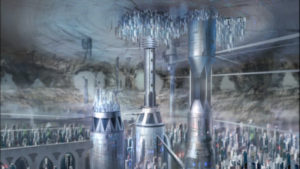 The same rating of “ok, but a bit bland” goes for the character animations and backgrounds and even the show’s music. I would, however, like to give a little shout out to the show’s battle theme which actually has a bit of fun punch to it. Despite everything else, I did find myself getting a little pumped up whenever that theme kicked in.
The same rating of “ok, but a bit bland” goes for the character animations and backgrounds and even the show’s music. I would, however, like to give a little shout out to the show’s battle theme which actually has a bit of fun punch to it. Despite everything else, I did find myself getting a little pumped up whenever that theme kicked in.
All In All:
There are space anime with more compelling casts, better art, and more exciting action, but that doesn’t mean that Strain is not worth watching. Sara’s highs and lows are fairly compelling. The core story is actually kinda clever in the way it uses the sci-fi setting. The resolution is genuinely good. Just… watch out for episode 7, the out of place goofy fan service episode.
The story of Ralph Werec, his mission to save the research ship, and the crazy time dilation effects he experiences chasing the ship down are really cool. Because of the speed at which Ralph traveled, most of his story took place long after the events of the anime. He was then sent back in time to avenge the aliens he unknowingly killed.
6361 – Aliens first discovered
7003 – Ralph is deployed to save the research ship
7005 – Ralph defeats the remaining alien fighters, Sara is defeated by Ralph on Grabera
7012 – Sarah’s final battle against Ralph begins
7137 – Sarah defeats Ralph
7564 – Ralph get to research ship and is sent back in time – yes, long after the events of the anime!
It gets a little tricky. All the dates except the last one are listed in Ralph’s local time. The last one is in Sara’s and shows the full effects of Ralph’s faster than light travel. The research ship under attack sent a signal to the union forces who then had centuries to develop Strains and come to their rescue? Does it work? Do the timelines match up? I’m not actually totally sure!
Even so, I really like the time travel part of the plot. Even if the dates don’t align perfectly, the idea that time dilation could let you deploy piloting a fighter that was invented based on technology still on the ship you are being sent to save is pretty trippy. I applaud that cool bit of sci-fi!
Review: Revue Starlight: The LIVE #1
In Short:
Performed a year before the release of the Revue Starlight anime, the first Revue Starlight stage play tells a similar story complete with some familiar songs and fun choreography. This stage play is notable because the nine core live action stage actresses went on to voice their same roles in the anime.
Though it may just be an unfortunate trick of the camera, a lot of the projected graphics used for character introductions and magical combat effects appear to be very dim in the DVD / Blu-Ray version of the play and are not as impactful or as easy to see as they might have been when viewed in person.
Full Review:
 I’ve come to love Revue Starlight, the anime. It combines fun characters, great music, and a strong appreciation of the stage to create an outstandingly unique show. But, Revue Starlight is more than just an anime. At this point, it’s a moderately large multi-medium franchise that includes: Three multi-volume manga, a single cour anime along with an upcoming followup movie, at least four live action stage plays, and an ongoing mobile game that continues to add new stories. It’s the first of these stage plays I’d like to focus on today.
I’ve come to love Revue Starlight, the anime. It combines fun characters, great music, and a strong appreciation of the stage to create an outstandingly unique show. But, Revue Starlight is more than just an anime. At this point, it’s a moderately large multi-medium franchise that includes: Three multi-volume manga, a single cour anime along with an upcoming followup movie, at least four live action stage plays, and an ongoing mobile game that continues to add new stories. It’s the first of these stage plays I’d like to focus on today.
First showing in 2017, “Shōjo Kageki Revue Starlight: The LIVE #1” tells a similar story to the anime where nine stage girls fight in magical Revues in order to try and win the position of the Top Star of their music academy’s 99th class. I wasn’t exactly sure what I was getting into when I decided to watch the stage play. Would it be the same story as the anime but stuck on a more limited stage? Would it be a condensed, unfinished, prototype version of the anime? Would it be a different story altogether? It turns out, it’s actually pretty good on its own merits while still being similar to the anime.
 The play opens with our two main characters, Karen and Hikari, as children enjoying the pivotal, tragic scene of the in-universe Starlight stage play. We learn about the two’s promise to become stars of the stage together and of their abrupt childhood parting. We then cut to several years later and are introduced to the eight main member’s of Seisho Music Academy’s 99th class. Each is a different personality and each gets a fun self-sung musical introduction to let the audience know who they are and what they are about. From the proper, rules-following class representative Junna, to the egotistical Maya and Claudine, to the shy Mahiru and Banana, to the larger than life Kaoruko and Futaba, each character rings true. It’s only later that our lead character, Karen, is found sleeping in a separate classroom. Her musical introduction was especially fun and silly!
The play opens with our two main characters, Karen and Hikari, as children enjoying the pivotal, tragic scene of the in-universe Starlight stage play. We learn about the two’s promise to become stars of the stage together and of their abrupt childhood parting. We then cut to several years later and are introduced to the eight main member’s of Seisho Music Academy’s 99th class. Each is a different personality and each gets a fun self-sung musical introduction to let the audience know who they are and what they are about. From the proper, rules-following class representative Junna, to the egotistical Maya and Claudine, to the shy Mahiru and Banana, to the larger than life Kaoruko and Futaba, each character rings true. It’s only later that our lead character, Karen, is found sleeping in a separate classroom. Her musical introduction was especially fun and silly!
After introductions, we get a lot of good character banter that hits on one of the core problems these stage girls face: They only seen each other as on-stage rivals, not partners, and while some shine individually, their inability to work together hampers their performances. The teaching staff, here, take on the roles as something akin to narrators who help move the plot along. Soon the girls are forced into the Trial of Legend where they compete against a chorus of stage hands and extras in musical combat where it again becomes apparent that the eight girls can’t work together properly.
 It’s then that Karen’s childhood Hikari arrives as a transfer student from a more prestigious school in London and helps save the day. Karen is thrilled to see her old friend again, but Hikari doesn’t seem to share the same enthusiasm. Eight of the nine soon receive a text message inviting them to special Revue auditions. The only one to not receive the message is the energetic but lazy Karen!
It’s then that Karen’s childhood Hikari arrives as a transfer student from a more prestigious school in London and helps save the day. Karen is thrilled to see her old friend again, but Hikari doesn’t seem to share the same enthusiasm. Eight of the nine soon receive a text message inviting them to special Revue auditions. The only one to not receive the message is the energetic but lazy Karen!
In the auditions, we see character pitted against character in one on one stage combat. Each girl transforms on stage into a military dress uniform and each uses a unique weapon from swords to daggers to even a bow to try and prove that they have more stage presence than their rival. These multiple ongoing battles are a lot of fun, and there’s some cool partially transparent panels set on wheels that are moved around the stage during this part to segment off and highlight the multiple concurrent battles. I thought this part was pretty clever and pretty well done.
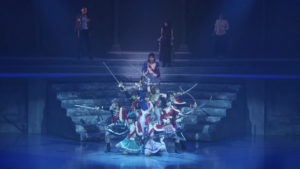 Ultimately, it’s Karen who wants to be friends with everyone who helps unify her class into working together. As partners, the girls put on one last musical combat spectacle as they work together to defeat the chorus. At the very end, the 99th class properly welcomes newcomer Hikari into their ranks, and everything ends happily.
Ultimately, it’s Karen who wants to be friends with everyone who helps unify her class into working together. As partners, the girls put on one last musical combat spectacle as they work together to defeat the chorus. At the very end, the 99th class properly welcomes newcomer Hikari into their ranks, and everything ends happily.
And then the second half of the show starts! You see, this whole event is broken up into the first half, which is a musical stage play that tells a complete story, and the second half, which is a more traditional idol style song and dance performance that’s just one song after another with no plot in between. Some of the songs are certainly catchy, and the dancing and movements are decent, there’s just not as much to say about this second half. You kinda just have to experience the songs for yourself.
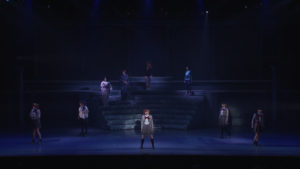 My favorite song in either half of the performance was “Watashitachi no Iru Riyuu” (The Reason We Are Here), which is actually a song that showed up a year later in the anime as “The Star Knows”. The anime version is a duet between Karen and Junna during their big Revue battle. In the stage play, it’s an ensemble song that shifts between each of the nine girls. The first half of the song is slower backed by a powerful piano and string solos. Each of the girls, in turn, sings about why they are stage girls. But, by the end, the song builds in tension and power as we learn that all the girls really have the same goal: they each want to find what makes them unique on stage. As it builds to a climax, percussion comes in and the song jumps quickly to each of the girls thoughts before unifying on them singing the same lines separately but together. It’s terrific!
My favorite song in either half of the performance was “Watashitachi no Iru Riyuu” (The Reason We Are Here), which is actually a song that showed up a year later in the anime as “The Star Knows”. The anime version is a duet between Karen and Junna during their big Revue battle. In the stage play, it’s an ensemble song that shifts between each of the nine girls. The first half of the song is slower backed by a powerful piano and string solos. Each of the girls, in turn, sings about why they are stage girls. But, by the end, the song builds in tension and power as we learn that all the girls really have the same goal: they each want to find what makes them unique on stage. As it builds to a climax, percussion comes in and the song jumps quickly to each of the girls thoughts before unifying on them singing the same lines separately but together. It’s terrific!
I like the Junna / Karen version in the anime since it’s really the first song that reveals the shape of the rest of the show, but I really, really love the song here in live action for it’s great little character moments and powerful conclusion.
 But it’s certainly not the only good song in the play. The earlier “Position Zero e!” Is a fun, upbeat number about the girls activities and goals at the music academy. “Star Divine”, which also appears in the anime as the climatic battle song, serves roughly the same purpose on the live action stage as the big number showing the girls shining together as a team. Finally, the second half of the event kicks off with an upbeat version of a fantastic song called “The Knowledge of a Stage Girl” which was later used in the anime. The animated version is a slow, happy reflection of what it means to be a stage girl. The live action version is considerably faster and more energetic and is used to get the crowd excited for the second half of the show. I like both versions a lot!
But it’s certainly not the only good song in the play. The earlier “Position Zero e!” Is a fun, upbeat number about the girls activities and goals at the music academy. “Star Divine”, which also appears in the anime as the climatic battle song, serves roughly the same purpose on the live action stage as the big number showing the girls shining together as a team. Finally, the second half of the event kicks off with an upbeat version of a fantastic song called “The Knowledge of a Stage Girl” which was later used in the anime. The animated version is a slow, happy reflection of what it means to be a stage girl. The live action version is considerably faster and more energetic and is used to get the crowd excited for the second half of the show. I like both versions a lot!
One final thing I’d like to address is what order this live action stage play and the anime should be watched in. They share a lot of similarities in characters and plot, but they are two distinct things. Ultimately, I think the anime should be watched first. Mostly, because since it has more time to tell its stories, there is more there to be spoiled. There’s a few instances in the stage play that reveal one character’s desires and those same desires play a much larger expanded role in the anime. Not knowing this character’s true desire is a key plot point of the anime, in fact. So, just for that reason alone, I’d recommend the anime first. I also liked having the anime depictions of the characters in my head as I watched the stage girls play the same parts. This isn’t so strange, I don’t think, because the anime version of each character gets a very brief appearance projected on stage during each of the live action girls’ short intros.
All In All:
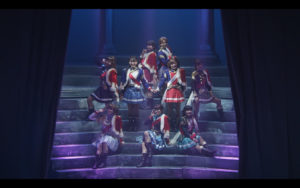 I thought the stage play was great. Each actress stuck to their character well. Each of them had something to do even if they weren’t currently under the spotlight. And, the songs often gave each character a chance to contribute and further highlight their personality. I’d probably give highest marks to the actress who had to physically embody the energetic yet timid Mahiru. Her jittery, smiley performance was very well done. The stage combat was pretty good with slashes and sword locks all supported by clanging sound effects. I’d rate this live action version of Revue Starlight a success. Its core story is somewhat different from the anime that came later, which I’ll talk about more in the Dig Deeper section, but is still strong in its own right even given the much more limited time the play had to work with.
I thought the stage play was great. Each actress stuck to their character well. Each of them had something to do even if they weren’t currently under the spotlight. And, the songs often gave each character a chance to contribute and further highlight their personality. I’d probably give highest marks to the actress who had to physically embody the energetic yet timid Mahiru. Her jittery, smiley performance was very well done. The stage combat was pretty good with slashes and sword locks all supported by clanging sound effects. I’d rate this live action version of Revue Starlight a success. Its core story is somewhat different from the anime that came later, which I’ll talk about more in the Dig Deeper section, but is still strong in its own right even given the much more limited time the play had to work with.
As Claudine Saijo might say: It was très bon!
Now that we’ve covered “was the play good and worth watching”, I’d like to dive into the specific similarities and differences between it and the anime. I’d say that the live action stage play and the anime are telling the same basic story. In both, Karen and Hikari become enamored by the play “Starlight” that they saw together as children and make a promise to one day become stars together. In both, Karen is too lazy to be invited to the Revues and Hikari transfers in devoid of passion because of a past defeat. All the other characters have extremely similar personalities and wishes and desires. The live action play has the stage girls act a little bit more antagonistic towards each other, but that’s resolved by the end of the play.
The biggest difference between the two are just how much more time the anime has to work with. Somethings that can be a quick song lyrics or lines of dialogue in the stage play are expanded to full episodes of the anime. I think it’s pretty clear that the stage play and anime were developed side by side, because those expanded storylines fit in great.
These changes do have some real impacts on the way the different stories flow:
- In the stage play, Futaba and Kaoruko’s fight is interesting because Kaoruko is pretty much in charge the entire time. She knows and recognizes that Futaba is the better stage performer so she uses her own superior acting ability to distract Futaba and get in a sucker punch of a final blow. The anime also has something of this, where Kaoruko tricks Futaba into closing the distance, but it is much more pronounced in the stage play. It’s also important to note that in the stage play, the two’s Revue battle harms their relationship somewhat, while in the anime, their Revue battle both improves Kaoruko’s work ethic and mends her relationship with Futaba.
- In the stage play, we only get one line about why Hikari returned. That maybe she’d been beaten in London and had to come crawling back. The anime shows us that entire series of events. What was a one line explanation in the stage play was turned into one of the biggest core plot points in the entire anime. That’s pretty cool.
- Likewise, the anime greatly expanded Banana’s role to the point that, really, three out of the twelve episodes focus on her while she was just a minor character in the stage play. Hearing live action Banana sing about not wanting to grow up and wishing time would stand still is actually pretty chilling coming from the anime where she straight up put her entire class, if not the entire world, into a time loop specifically so she could relive her class’ first performance of Starlight. Banana planning on repeating the loop is so well integrated into even the early episodes of the anime that I think it would be a shame to tip viewers off with some of the things she sings about in the stage play.
- Finally, any school staff we see in the anime are completely unaware of the Revues, but in the stage play the head of the academy is under orders from the giraffe to pit the girls against one another. This makes even the giraffe a more malevolent character than he is in the anime. He also only appears at the end of the stage play, so he’s quite a bit more mysterious, as well.
I think it’s great to have both versions of the story. It’s great to see a single good story told in different ways that are remolded to better support the medium they are being told in.
Review: Steins;Gate Anime
In Short:
Steins;Gate is a 2011 anime by White Fox that follows the humor and tragedy of self-proclaimed mad scientist Okabe Rintaro as he, and his friends, get in over their heads when they accidentally create a time machine by hooking up a cellphone to a microwave. Steins;Gate features great characters, witty dialogue, one of the better time travel plots around, and easily one of the best English dubs in all of anime.
Steins;Gate has a unique, desaturated art style that may not sit well with anime fans used to more colorful works. It is also one anime where you cannot use the “three episode rule” to determine its quality. Instead, it takes nearly twelve episodes for it to put all its pieces on the board. But, once it is finally ready, it goes all out for a thrilling, non-stop second half.
Suggested Minimum Watch: 3 episodes. You can’t give up on the show until Kurisu is made a lab member. But really, you should watch till episode 12…
Full Review:
 Okabe Rintaro, or “Hououin Kyouma” as he prefers to call himself just because it sounds cooler, likes to pretend he is constantly engaged in a secretive, high stakes battle for the future of humanity against a fictional group he calls “The Organization”. He often speaks in a grandiose, self-important tone, deflects scrutiny away from himself by pretending to get urgent phone calls as if he is a secret agent, and he likes to assign meaningless norse code names to his mundane tasks and projects as if he really is the mad scientist he claims to be.
Okabe Rintaro, or “Hououin Kyouma” as he prefers to call himself just because it sounds cooler, likes to pretend he is constantly engaged in a secretive, high stakes battle for the future of humanity against a fictional group he calls “The Organization”. He often speaks in a grandiose, self-important tone, deflects scrutiny away from himself by pretending to get urgent phone calls as if he is a secret agent, and he likes to assign meaningless norse code names to his mundane tasks and projects as if he really is the mad scientist he claims to be.
In reality, Okabe is an intelligent, if slightly eccentric, university student with a decent sense of humor who lives in a tiny second floor apartment which which he calls the Future Gadget Labratory. He and his best friend, computer hacker and fellow student Itaru “Daru” Hashida, frequently hang out together and come up with silly inventions in their spare time. Although he can in no way be called normal, Okabe mostly keeps up his mad scientist act for the benefit and delight of his childhood friend Mayuri Shiina.
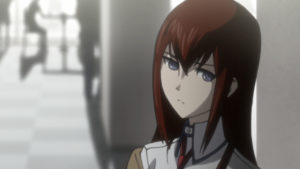 One day, while attending a lecture on the possibility of time travel, Okabe is pulled out into a hallway by genius university student Makise Kurisu. Strangely, Makise demands to know what Okabe wanted to tell her earlier… which is odd because Okabe has never spoken to her before in his life. Stranger still, just minutes later, Makise later ends up lying dead in a pool of her own blood at that same conference! But, strangest of all, is that everything seems to shift when Okabe texts news of Makise’s murder to Daru. Okabe soon finds out that the events of the past day have drastically changed. In this new timeline, Makise is still very much alive. In fact, she is the one now holding a talk on the impossibility of time travel.
One day, while attending a lecture on the possibility of time travel, Okabe is pulled out into a hallway by genius university student Makise Kurisu. Strangely, Makise demands to know what Okabe wanted to tell her earlier… which is odd because Okabe has never spoken to her before in his life. Stranger still, just minutes later, Makise later ends up lying dead in a pool of her own blood at that same conference! But, strangest of all, is that everything seems to shift when Okabe texts news of Makise’s murder to Daru. Okabe soon finds out that the events of the past day have drastically changed. In this new timeline, Makise is still very much alive. In fact, she is the one now holding a talk on the impossibility of time travel.
Makise and Okabe verbally spar over time travel theories at the lecture with Okabe coming out on the losing end. But still, Makise is intrigued enough by Okabe’s claims saying time travel is possible that she comes to visit him at his Future Gadget Laboratory apartment. Though the two frequently argue and spar and tease each other endlessly, they are both dedicated to the pursuit of science and actually hit it off fairly well despite a rocky start. The way these two characters interact is just brilliant and becomes even more so as the show moves into its non-stop second half. A scene where the more serious Makise at one point imitates Okabe’s eccentric mannerisms is easily a top highlight of the show.
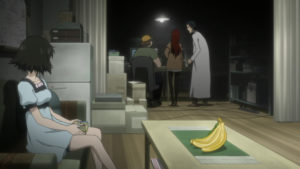 And that brings us to pacing. Steins;Gate is somewhat known for its slow start, and for good reason. For the first three or four episodes, you’re kinda left wondering if this time travel thing the show seems to be built around is even real. And, if it is real, will it ever be consequential enough to carry a twenty four episode series? The constant setbacks and limited time travel successes Okabe and friends achieve with their strange cellphone activated microwave almost leads you to believe that Steins;Gate is going to be about the boring, unimportant subtleties of time travel. But that’s not the case at all!
And that brings us to pacing. Steins;Gate is somewhat known for its slow start, and for good reason. For the first three or four episodes, you’re kinda left wondering if this time travel thing the show seems to be built around is even real. And, if it is real, will it ever be consequential enough to carry a twenty four episode series? The constant setbacks and limited time travel successes Okabe and friends achieve with their strange cellphone activated microwave almost leads you to believe that Steins;Gate is going to be about the boring, unimportant subtleties of time travel. But that’s not the case at all!
Every episode in the first half of Steins;Gate is packed with good character moments and interesting plot developments, even when those developments are occasional subtle. As an example, Okabe and friends at one point early on try to prove they can send messages back in time by attempting to win the previous day’s lottery. It’s a classic time travel trope. And their plan works… except the person they send the winning lottery numbers to gets them mixed up and they don’t end up winning after all. That’s the sort of thing that keeps occurring in the first half of Steins;Gate. Except it’s not the whole story.
 The closer Steins;Gate gets to it’s half way point, the more show ratchets up it’s level of tension. Things that seem innocent or incidental at first keep becoming more and more important and keep intruding more and more on the somewhat leisurely flow of the plot. Little by little, the story starts to accelerate, and you do start to see major consequences caused by Okabe’s meddling in time travel. By the time you reach the halfway point you know something big is going to happen. And then it does. And from then on the show’s pace changes from lazily drifting down a stream to battling the toughest white water river rapids imaginable. You quickly come to realize that the first half of the show was like the long slow pull up the first big hill of a roller coaster. Once you get to the top, the show doesn’t stop and doesn’t let up until it puts you through a series of thrilling high speed loops and drops and turns that continue all the way to the end.
The closer Steins;Gate gets to it’s half way point, the more show ratchets up it’s level of tension. Things that seem innocent or incidental at first keep becoming more and more important and keep intruding more and more on the somewhat leisurely flow of the plot. Little by little, the story starts to accelerate, and you do start to see major consequences caused by Okabe’s meddling in time travel. By the time you reach the halfway point you know something big is going to happen. And then it does. And from then on the show’s pace changes from lazily drifting down a stream to battling the toughest white water river rapids imaginable. You quickly come to realize that the first half of the show was like the long slow pull up the first big hill of a roller coaster. Once you get to the top, the show doesn’t stop and doesn’t let up until it puts you through a series of thrilling high speed loops and drops and turns that continue all the way to the end.
If it’s solid, exciting time travel plot is one of Steins;Gate’s strengths, its characters are its other strong point.
Okabe plays the role of pretend mad scientist with equal parts charm and delusion. He’s really not so out of the ordinary when he occasionally drops out of his crazier persona, but when he is fully in his role as mad scientist Hououin Kyouma, he can be quite egotistical and infuriating to his friends.
Daru plays a great straight man to Okabe’s mad scientist, but he can be just as wacky as Okabe thanks to his occasional semi-lewd observations and his devotion to his online video game character harem that he has to keep up with.
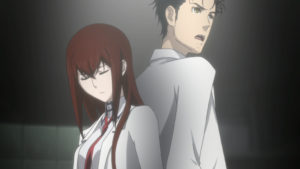 Then there’s Makise who really is the show’s second main character. She is intelligent and witty and is constantly verbally sparing with the goofier Okabe over everything from legitimate scientific theory to how bad she is at cooking. One of the funnest things about Makise is she’s just as much of a nerd as Okabe and Daru are, but unlike them, she does her best to keep that fact hidden. Her attempts to hide her knowledge of nerd culture lead to some of the best lines of dialogue in the series, and Okabe’s teasing, antagonistic love/hate relationship with her is a highlight of the show.
Then there’s Makise who really is the show’s second main character. She is intelligent and witty and is constantly verbally sparing with the goofier Okabe over everything from legitimate scientific theory to how bad she is at cooking. One of the funnest things about Makise is she’s just as much of a nerd as Okabe and Daru are, but unlike them, she does her best to keep that fact hidden. Her attempts to hide her knowledge of nerd culture lead to some of the best lines of dialogue in the series, and Okabe’s teasing, antagonistic love/hate relationship with her is a highlight of the show.
Steins;Gate also has a small cast of interesting characters who help or hinder Okabe in various ways. The stories of these seemingly minor characters are a lot more personal and fleshed out than you might expect, and actually play a larger role in the main story than you might at first think. There are some great, weighty moments that I don’t want to spoil, but check out the Dig Deeper section below if you are interested in learning more about these side stories and why they are included alongside the main plot.
 One final thing that makes Steins;Gate’s story so good is that it pulls in a lot of real world elements and twists them around for its own fictional purposes. For instance, time traveler John Titor actual was the originator of the time travel theories that the lecturer plagiarized at the beginning of the first episode. “John Titor” was a real username who posted on message boards about time travel back in 2001. Likewise SERN, a misspelling of the real world CERN, better known as the European Organization for Nuclear Research is a real world group of scientists who do high energy particle physics. Their fictional counterparts play a major role in Steins;Gate and help make the show feel more grounded in reality than it otherwise would.
One final thing that makes Steins;Gate’s story so good is that it pulls in a lot of real world elements and twists them around for its own fictional purposes. For instance, time traveler John Titor actual was the originator of the time travel theories that the lecturer plagiarized at the beginning of the first episode. “John Titor” was a real username who posted on message boards about time travel back in 2001. Likewise SERN, a misspelling of the real world CERN, better known as the European Organization for Nuclear Research is a real world group of scientists who do high energy particle physics. Their fictional counterparts play a major role in Steins;Gate and help make the show feel more grounded in reality than it otherwise would.
Graphics & Sound
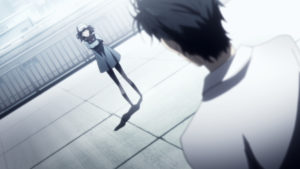 Graphically, Steins;Gate is… different. It has plenty of detail in its characters and backgrounds, and while it’s by no means an animation powerhouse, it gets by well enough. What makes it a little odd is its palette and style that sorta sucks the color out of most of its scenes. Indoors, this mostly just means that a lot of the colors, especially the background colors, are somewhat muted. But outdoors, the show often combines its subdued colors with bright glare meant to convey the heat of summer. This subdued but also blown-out look was a little distracting to me at first and took a while to get used to. I wouldn’t even say its unique style is used to any great effect. It simply is what it is and you can like it or not. Personally, I kinda don’t.
Graphically, Steins;Gate is… different. It has plenty of detail in its characters and backgrounds, and while it’s by no means an animation powerhouse, it gets by well enough. What makes it a little odd is its palette and style that sorta sucks the color out of most of its scenes. Indoors, this mostly just means that a lot of the colors, especially the background colors, are somewhat muted. But outdoors, the show often combines its subdued colors with bright glare meant to convey the heat of summer. This subdued but also blown-out look was a little distracting to me at first and took a while to get used to. I wouldn’t even say its unique style is used to any great effect. It simply is what it is and you can like it or not. Personally, I kinda don’t.
Where Steins;Gate shines, however, is in its dialogue and voice acting. It’s fine in Japanese, and there’s some great moments like Okabe’s odd broken English greeting to a back alley vendor, but I will probably never watch it in Japanese again because the show is stellar in English. Steins;Gate is one of maybe five anime that I’ll hold up as incontrovertibly better in English than they are in Japanese. In either language, Steins;Gate’s dialogue is fast paced and witty, but in English, Funimation both provided great voice actors and made some substantial changes to the dialogue to make it flow better for an English audience.
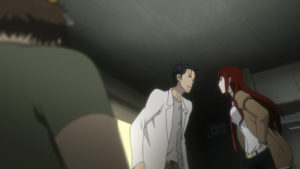 What this means is, the English dialogue and acting in Steins;Gate is among the best of the best. Conversations flow brilliantly and you can hear every emotion the characters are conveying. But it also means that English dub is very decidedly not a direct translation. If that matters to you, by all means stick to the Japanese. In most places, this is wonderful. In episode 9, for instance, the English dub swaps out a confusing joke about @channel (Steins;Gate’s in-universe version of Twitter) for a trio of sly references to Star Trek. This kind of thing happens throughout the series. The English dub never changes the intent of the characters and it doesn’t at all alter the plot, but individual words, sentences, and exchanges can and do sometimes end up a bit different in the English version than they were in Japanese.
What this means is, the English dialogue and acting in Steins;Gate is among the best of the best. Conversations flow brilliantly and you can hear every emotion the characters are conveying. But it also means that English dub is very decidedly not a direct translation. If that matters to you, by all means stick to the Japanese. In most places, this is wonderful. In episode 9, for instance, the English dub swaps out a confusing joke about @channel (Steins;Gate’s in-universe version of Twitter) for a trio of sly references to Star Trek. This kind of thing happens throughout the series. The English dub never changes the intent of the characters and it doesn’t at all alter the plot, but individual words, sentences, and exchanges can and do sometimes end up a bit different in the English version than they were in Japanese.
There’s not a lot to talk about in terms of music for Steins;Gate. There is some music, I guess, during tense or important scenes, but I can hardly recall it. What did stand out to me, though, was its opening theme. “Hacking to the Gate” is upbeat and relevant to the plot without being any kind of direct spoiler. I still listen to it on occasion, but this is not a show where I picked up the full instrumental score like I do for some of my other favorites.
All In All:
Steins;Gate is one of my favorite anime of all time. Its combination of great characters, fantastic witty dialogue, and a very strong time travel plot kinda checked all the boxes for me. Yes, it’s a little slow in the beginning, but rest assured that things really do build on themselves and pick up as the show approaches the half-way mark. Steins;Gate has tension, and emotion, and excitement to spare, it simply doesn’t show its full hand nearly as quickly as some other shows. But once it does hit its proverbial 88 miles per hour, you will, indeed, see some serious shit! (What?! I had to get a Back to the Future reference in there somewhere!)
Steins;Gate’s Visual Novel Influences:
One of the interesting points that I kinda feel is necessary to fully understanding Steins;Gate – the anime – is that it was based upon Steins;Gate – the visual novel. For those that don’t know, Visual Novels are a popular type of role playing game in Japan. In them, you typically play a lead character in a story and you travel around various locations in an area such as a town and have branching conversations with several other characters. But it’s almost all presented in fixed screens and backgrounds and unmoving character art instead of in 3d like an open world game. Visual Novels often have several different endings depending on who you talk to and what what you say to them and what dramatic choices you make.
Steins;Gate is one of the better known Visual Novels, but there are other anime based on Visual Novels you might recognize. For instance, Fate/stay night was also originally a Visual Novel. In the Steins;Gate game, you played as Okabe and, along with talking to the characters represented in the anime, you could also receive text messages from the future where acting on them was critical to get one of the better endings. To get the best ending, which is basically the one depicted in the anime, you almost had to replay the game multiple times so you could act on information you learned during your previous failures.
Steins;Gate’s original form being a Visual Novel also plays into some of the anime’s plot choices. The various one off episodes where Okabe spends time with each of the girls and rolls back their altered futures comes directly from the Visual Novel. Depending on your choices Okabe could end up paired off with any one of the girls in one of the game’s multiple good endings. Or he could end up dead in various ways in the game’s multiple bad endings. The anime pays respect to that by working in most of those sub stories that were mutually exclusive from each other. You actually had to play the game several times to see each of the endings.
In the anime, I thought this worked fine, but it does shed a little light on why the anime seemed to string a few side stories together and made them critical to progressing the main story of saving Mayuri and Makise.
The Almost Perfect Time Travel Plot:
Out of all the time travel shows and movies I’ve seen, I think Steins;Gate has one of the best, most consistent time travel plots out there. All the pieces fit into place across several timelines and several failed attempts to set things right… except one thing. I’ve never been able to justify the video Okabe gets from himself being static the first time he looks at it. Oh, the justification in the show is fun and clever… that it was locked or inaccessible until he moved onto the worldine where he killed Makise, or some such thing. But how does that make any sense? I think it would have been better if he’d never looked at the video of if it had been slow to download so he didn’t have time to look at it before he had to rush to see Makise seemingly dead in the hallway. The way it is now, it feels like the one puzzle piece that doesn’t fit into the great time travel plot.
Review: Land of the Lustrous Anime
In Short:
Land of the Lustrous is a 2017 anime by CGI powerhouse Orange about a small group of immortal, genderless people whose entire bodies are made of the gemstone or mineral each is named after. While most of the gems, like Jade or Diamond, are content to carry out their same routines day after day, just as they have for hundreds or even thousands of years, the show’s focus on the spunky but naive and physically brittle Phosphophyllite rewards viewers with one of anime’s best character arcs.
For better or worse, the anime only covers the first few chapters of the manga it is based on. So, while Land of the Lustrous tells an interesting story filled with great characters, some spectacular combat, and a deft combination of fun humor and intense drama, it does end just when it seems the real story is about to begin.
Suggested Minimum Watch: 2 episodes. It would be a big shame to quit the show before you get to meet Dia and Bort.
Full Review:
Land of the Lustrous (houseki no kuni) is one of those rare anime that requires a lot more explanation than usual simply because its setting is so different from anything else out there. It’s not set in a high school, or on a military space ship, or a sports field, or really anywhere else your typical anime is.
 At its simplest, Land of the Lustrous is an anime about a group of immortal sentient humanoid gemstones living together on an otherwise uninhabited grassy island. The gems are primarily organized by their hardness, durability, and personality. The green haired Jade, for instance, is logical and factual and serves the role as the group’s day to day organizer. Bort, with its long black hair and cold, demanding demeanor is the most durable of all the gems and so it serves as their most potent defender. Other gems take on a variety of roles from lookouts to gathers to even a clothing designer and a surgeon of sorts.
At its simplest, Land of the Lustrous is an anime about a group of immortal sentient humanoid gemstones living together on an otherwise uninhabited grassy island. The gems are primarily organized by their hardness, durability, and personality. The green haired Jade, for instance, is logical and factual and serves the role as the group’s day to day organizer. Bort, with its long black hair and cold, demanding demeanor is the most durable of all the gems and so it serves as their most potent defender. Other gems take on a variety of roles from lookouts to gathers to even a clothing designer and a surgeon of sorts.
The gems do not age and cannot really die. They essentially just lose consciousness if sufficiently dismembered, but even if they are shattered by an accident or by an attack, they can always be pieced back together and wake up good as new. They don’t breath, so operating underwater is not much of a hinderance. They don’t eat, per say, since they get their nourishment and energy from the sun, so even food is mostly a non-issue for them. It does mean that they tire easily at night to the point of sometimes falling asleep unintentionally, and that they spend the long cloudy winters in hibernation, but they can, with effort, stay awake, so even those actions are more an inconvenience than an outright limitation. The gems also store their memories all throughout their bodies instead of just in a brain. This means that if they are shattered but not put completely back together they can forget things they once knew. But, since they are immortal, it is rare for them not to be able to track down all the pieces of one of their companions.
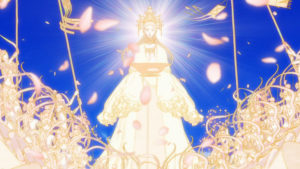 The only true enemy the gems have are the show’s second set of strange, otherworldly creatures: the Lunarians. Their sole goal appears to be to shatter the gems and cart them back off to the moon for some unknown purpose. Each time they appear, they emerge in the sky out of what looks to be strange ink blots that open to reveal a small army riding on a large yellow disc of clouds that hovers above the island. These raiding parties are armed with bows and spears, but they almost seem more ritualistic than warlike, as roughly half the Lunarians in each raid come playing drums, tambourines, or flutes, while others hold flags and banners. If anything, the Lunarians appear to be based in Budist imagery. Interestingly, the Lunarians appear to be made of clouds themselves. They are the same yellow color as the clouds they ride on and they blow away when defeated.
The only true enemy the gems have are the show’s second set of strange, otherworldly creatures: the Lunarians. Their sole goal appears to be to shatter the gems and cart them back off to the moon for some unknown purpose. Each time they appear, they emerge in the sky out of what looks to be strange ink blots that open to reveal a small army riding on a large yellow disc of clouds that hovers above the island. These raiding parties are armed with bows and spears, but they almost seem more ritualistic than warlike, as roughly half the Lunarians in each raid come playing drums, tambourines, or flutes, while others hold flags and banners. If anything, the Lunarians appear to be based in Budist imagery. Interestingly, the Lunarians appear to be made of clouds themselves. They are the same yellow color as the clouds they ride on and they blow away when defeated.
For the most part, the gems are content to live their immortal lives doing the same thing day in and day out for years, decades, centuries, and even millennia at a time. Although there are some, like the doctor Rutile, who show curiosity in their specific fields of expertise, it seems pretty clear that the gems are not especially inquisitive and prefer to simply carry out the roles given to them by their leader, Sensei Kongo.
But then there’s Phos.
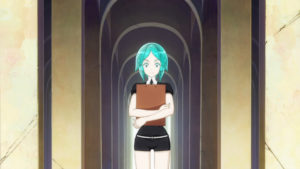 Phos, short for Phosphophyllite, is a brittle, easily cracked peppermint green gem who bears the distinction of being the only one of the gems to not have an assigned task. Phos is upbeat, happy, energetic, and spunky. It is also clumsy, prone to complaining and talking back, and more than a little inattentive. For the first nearly 300 years of its life, Phos has just lounged around in the sun doing little more than occasionally annoying its fellow gems. In all that time, Sensei Kongo has been trying to find a task that the short attention spanned and easily broken Phos can carryout without wandering off or being shattered. Phos seems to be a poor choice for any sort of repetitive task, and even though they wish to take part in what they naively see as the glamour and excitement of combat against the Lunarians, they are far too fragile to do so.
Phos, short for Phosphophyllite, is a brittle, easily cracked peppermint green gem who bears the distinction of being the only one of the gems to not have an assigned task. Phos is upbeat, happy, energetic, and spunky. It is also clumsy, prone to complaining and talking back, and more than a little inattentive. For the first nearly 300 years of its life, Phos has just lounged around in the sun doing little more than occasionally annoying its fellow gems. In all that time, Sensei Kongo has been trying to find a task that the short attention spanned and easily broken Phos can carryout without wandering off or being shattered. Phos seems to be a poor choice for any sort of repetitive task, and even though they wish to take part in what they naively see as the glamour and excitement of combat against the Lunarians, they are far too fragile to do so.
Phos is the lead character of the show, and deservedly so. Early on, it is tasked by Sensei Kongo to compile an encyclopedia for the other gems. It immediately tries to find a way out of the job either by getting others to fill in for it, or by at least roping one of the other gems in as an assistant. In the early episodes, Phos’ wit and spunk shine, filling each scene with humor and laughs. Land of the Lustrous could have easily padded out its twelve episodes with Phos’ delightfully dismissive antics, but it goes far above and beyond that. Where this could have been a show of nothing but humor, Land of the Lustrous is actually more an examination of tragedy and change, with most of that change happening to Phos itself. One of the strongest points of the show is the arc Phos goes through. The Phos we see by the end of the twelfth episode is a far different character than the Phos we get in episode one.
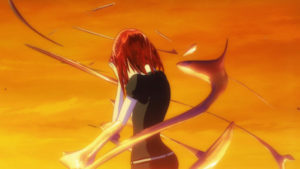 Phos’ journey is set in motion by Cinnabar, a second oddity among the gems. Where most of the gems, including Phos, live together on the island, Cinnabar lives alone away from the others by its own choice. Cinnabar, you see, is literally toxic to the plants and animals of the island thanks to the never ending flow of mercury it exudes. This mercury is even dangerous to the other gems as it can damage their finish and prevent them from absorbing the sun’s rays. Early on, Phos hears that Cinnabar is very clever, so it tries to rope Cinnabar into its encyclopedia task only to learn Cinnabar has a tragic secret.
Phos’ journey is set in motion by Cinnabar, a second oddity among the gems. Where most of the gems, including Phos, live together on the island, Cinnabar lives alone away from the others by its own choice. Cinnabar, you see, is literally toxic to the plants and animals of the island thanks to the never ending flow of mercury it exudes. This mercury is even dangerous to the other gems as it can damage their finish and prevent them from absorbing the sun’s rays. Early on, Phos hears that Cinnabar is very clever, so it tries to rope Cinnabar into its encyclopedia task only to learn Cinnabar has a tragic secret.
Although Cinnabar is tasked with performing the night watch for the other gems thanks to the way its mercury lets it live off starlight, this tasks is actually pointless and futile. The Lunarians have never once, in several thousands years, appeared after sundown. When Phos finally meets Cinnabar, the latter admits it would welcome being incapacitated and taken away to the moon if only to end its monotony and isolation. Day after day and night after night Cinnabar stands waiting for the Lunarians to come for it, yet, for some reason, they never do. That it isn’t even desired by the Lunarians only serves to push Cinnabar into further self-loathing.
 When Phos learns of this shocking, bitter secret, it makes a hasty yet sincere promise to Cinnabar to find them a better job than the night watch. To find Cinnabar a job that only it can do. This heartfelt promise from the flighty Phos, who has likely never promised anyone anything like this before, drives much of the plot throughout the rest of the show.
When Phos learns of this shocking, bitter secret, it makes a hasty yet sincere promise to Cinnabar to find them a better job than the night watch. To find Cinnabar a job that only it can do. This heartfelt promise from the flighty Phos, who has likely never promised anyone anything like this before, drives much of the plot throughout the rest of the show.
Graphics & Sound
One of the first things you often hear about Land of the Lustrous is how it is computer animated. This is a rather divisive issue among anime fans as 3d computer animated shows are often thought to be more clunky and less fluid and expressive than 2d hand drawn shows. Land of the Lustrous got around these problems by taking the best of both worlds. Orange brought in noted 2d animators to help with storyboarding and combat scenes. They would sometimes literally draw expressive line art on top of the unfinished computer animations to give the computer animators tips and goals to shoot for, ensuring that the show remained just as expressive as the best hand drawn anime.
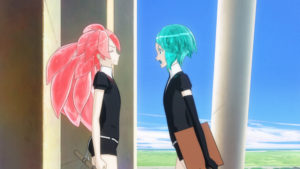 Orange also recorded the voice actors first and did the animations second. This is opposite of the way most 2d and 3d anime are done. By recording the voices first, it gives the animators something to work off of. They were able to time movements and invent new animations that added fluidity in time with each characters’ already recorded voices. The end results is that Land of the Lustrous has an extra level of snappiness and expression that you don’t often get in anime.
Orange also recorded the voice actors first and did the animations second. This is opposite of the way most 2d and 3d anime are done. By recording the voices first, it gives the animators something to work off of. They were able to time movements and invent new animations that added fluidity in time with each characters’ already recorded voices. The end results is that Land of the Lustrous has an extra level of snappiness and expression that you don’t often get in anime.
But beyond all that, the show is just beautiful! Land of the Lustrous makes brilliant use of lighting and color. The island the gems live on is detailed and scenic from its wave-swept beaches to its marshy forests to the two white stone structures the gems live in. It had me captivated by the very first blade of green grass that came on the screen.
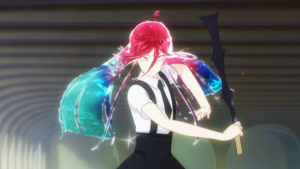 Each gem looks spectacular, as well, with their own diverse styles and colors of translucent hair that casts light on nearby objects and environments. One of my favorite visual tricks the show pulls is showing that the irises of each gem are, in fact, composed of a complex facet of gemstone shapes that appear whenever the camera gets close enough. The Lunarians, too, have such an interesting and creepy look to them that feels so different from everything else in the show. They have an entirely different visual style that can at times be awe inspiring.
Each gem looks spectacular, as well, with their own diverse styles and colors of translucent hair that casts light on nearby objects and environments. One of my favorite visual tricks the show pulls is showing that the irises of each gem are, in fact, composed of a complex facet of gemstone shapes that appear whenever the camera gets close enough. The Lunarians, too, have such an interesting and creepy look to them that feels so different from everything else in the show. They have an entirely different visual style that can at times be awe inspiring.
A lot of the show’s general look and feel comes from its manga. While the Land of the Lustrous anime is not a shot for shot recreation, it does take some of the best panels from the manga and mixes them up where necessary to make a more compelling tv show. This is a fine line to walk, as showing the same scene from a different angle could ruin it, but Orange pulled it off with room to spare. Check the Dig Deeper section below for some links to videos that go in-depth about the show’s visuals.
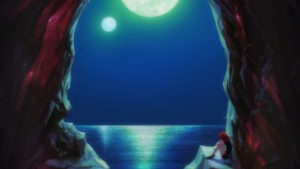 On the audible front, I love this show’s sounds and music just as much as I love its colors and animation. There’s this great mix of piano and strings and horns and more exotic instruments that come together to create a wide variety of moods. Special call out goes to the chillingly strong piano notes of the main theme you get just seconds into starting the first episode.
On the audible front, I love this show’s sounds and music just as much as I love its colors and animation. There’s this great mix of piano and strings and horns and more exotic instruments that come together to create a wide variety of moods. Special call out goes to the chillingly strong piano notes of the main theme you get just seconds into starting the first episode.
I actually bought the soundtrack to this one like I do for all the anime whose music I love, and it’s been great to listen to Phosphophyllite’s upbeat, hopeful theme as well as the sad, worrisome, lonely theme provided to Cinnabar. Then, of course, there’s Sunspot, the strange theme filled with bells and tambourines that plays whenever the Lunarians appear. The battle theme, Battle, is great too!
 I also love the show’s opening. It has a complexity about both its graphics and audio that is entrancing. It’s also interesting because while Phos is the one who dominates the screen, the song itself appears to be sung by Cinnabar. Listen closely to the lyrics where the singer talks about being the only one to wander through the night. Those words don’t belong to Phos or any of the other gems!
I also love the show’s opening. It has a complexity about both its graphics and audio that is entrancing. It’s also interesting because while Phos is the one who dominates the screen, the song itself appears to be sung by Cinnabar. Listen closely to the lyrics where the singer talks about being the only one to wander through the night. Those words don’t belong to Phos or any of the other gems!
Finally, in regards to voice acting, Land of the Lustrous is excellent there as well. The Japanese cast did an amazing job bringing their respective characters to life. Phos’ voice actress, in particular, brings a ton of energy and fun to the character. The show’s English dub is also very good. The Japanese cast set a hard act to follow, but the English actors did a great job. I was a little afraid for the English dub just because of how fast paced and nuanced characters like Phos could be at times, but the English actors for Phos and the other gems matched those performances to my satisfaction.
All In All:
Land of the Lustrous is an interesting show that is unique even among other great anime. Its setting and concepts are delightfully alien while still being relatable. Its look, animation, and sound are excellent. And, its characters’ desires and motivations, especially those of its lead character Phos and secondary character Cinnabar, are complex in ways you may not expect from just watching the first episode.
Even though it tells an enjoyable story on a surface level, Land of the Lustrous is, in some ways, one of the most complex anime I’ve ever recommended. Its characters and their motivations are often pulled in opposite directions. The show itself has overarching and deeply rooted Buddhist themes. And, the show is bold enough to often have its characters greatest learning moments be their biggest failures. I may be a little scattered here, because there is so much to talk about, but let me share a few things that I think push Land of the Lustrous above and beyond.
One of my favorite parts of Land of the Lustrous is just how much Phos changes throughout the course of the show. The final episode has a great moment where Phos looks back at its past self, but there are some great moments along the way that made me love Phos all the more.
After Phos gets its new legs and its super speed, it joins the Amethyst twins and quickly finds out that joining the other gems out on patrol is not nearly as cools as it had hoped. It was great to see Phos spend the entire first day jumping at every little thing that happened. A few days later, we see that Phos has already grown tired of waiting. It was a neat demonstration on how sometimes the fantasy of a thing doesn’t match the reality.
Another great moment is when Phos is chasing down the Lunarians that are stealing away Antarcticite. Phos’ lines about overcoming its limits but still failing were unexpectedly powerful to me. In most other shows, Phos would have succeeded, having finally come to grips with the responsibility it owed its fellow gems, but that wasn’t the point here. I loved the way Land of the Lustrous used hope followed by further failure to grow Phos’ character.
Cinnabar also got some neat subtle moments. Throughout the series, Cinnabar all but refuses to interact with the other gems. Even when it could have stepped out of the shadows and alerted all the gems looking for Phos under the sea, it didn’t. Why not? It all comes back to Cinnabar’s true motivations for staying away.
Yes, Cinnabar was tired of being alone and terribly distraught at the way its poisonous mercury harmed and killed everything around it, but that wasn’t the real reason Cinnabar stayed away. Instead, listen again to what Cinnabar says in the first episode when it is complaining to itself about wanting to be free of the night. It also says that no, it can’t trust Phos.
For the longest time I forgot about that part. It seemed out of place and unimportant, until it was made clear that Cinnabar didn’t trust Sensei Kongo and the other gems precisely for the same reasons as Phos is losing trust at the end of the series. Cinnabar had long ago determined that there was some link between Kongo and the Lunarians, but unlike the other gems who were mostly content to continue on with their lives, Cinnabar distanced itself from Kongo and thus the gems that he led. I love how this second layer gives Cinnabar’s actions so much more meaning once you realize what is going on.
Finally, there’s something I didn’t want to talk about in the main review. It’s that I’m actually happy that Land of the Lustrous has not gotten a second season. I kinda don’t want it to ever get another season even though it does end itself on a major cliffhanger. This is because I don’t like the direction the manga heads in. What I wanted to happen is for Cinnabar and Phos to join forces and solve the mystery of the Lunarians together. Things didn’t need to end perfectly happy, but I was happy with where Phos and Cinnabar ended up by the end of the season. I wanted to follow those characters through to their eventual conclusion.
That doesn’t happen.
Instead, the manga sees Phos get more and more pieces replaced, most notably its head. Phos actually gets taken to the moon where it communicates and joins forces with the Lunarians. Phos eventually sparks a kind of civil war between the gems back on earth. There’s also the revelation that the Lunarians were grinding the captured gems into dust and spreading them out on the surface of the moon because they wanted Kongo to see and agree to their demands. I would be fine with that except the manga then breaks the rule about the gems always being able to be put back together. It is said that any of the weaker gems spread out this way had their inclusions bleached away and were truly dead. This included Antarcticite, which made me very unhappy.
In general the manga sounds like it just gets more and more unhappy, to the point that an even more drastically changed Phos at one point demands that Sensei Kongo murder it because it cannot live with itself and what it has done. I will check back once the manga finishes. A good ending could very well be worth all the turmoil to get there. But for now, I don’t want to read most of what I’ve heard about and consequently, I don’t want to see it animated either.
As usual, I do have a few recommendations if you want to learn more about this anime:
- Land of the Lustrous: A PERFECT Adaptation This video goes in depth for a shot for shot, panel for panel look at how the anime followed and expanded on its manga’s lead to create a fantastically artistic visuals.
- What Makes a Soundtrack Great – Land of the Lustrous & What Makes Cinnabar’s Theme So Emotional (Let’s Talk About The Erhu) takes a look at the show’s music in general, and Cinnabar’s theme in particular.
- The most complex pop anime OP looks at the crazy musical timing of Land of the Lustrous’ opening song.
- Finally, if you really love the show like I do, I highly recommend Nearly On Red’s fantastic 10+ hour Episode by Episode Breakdown that goes all in on examining the show’s plot and characters. Note, that an episode 12 breakdown exist as a twitch livestream viewing of the twelfth episode and more than an hour of comments afterwards.
Magma & Team IcyHot vs The Friendly Fortune Teller
Magma entered the small farming town she and her companions had agreed to visit, hopeful the job they had heard of was still there. It had been a long, exceedingly lonesome day of riding… and now, snow was beginning to fall as she searched the few streets and alleyways for the tavern her friends were to be at. Though not as bad as a heavy downpouring of rain, the darkened evening sky and falling icy flakes affixed a frown to the face of the dark-skinned Fire Genasi. None too soon, however, the faint sound of music called out to her, and lead her to where she needed to be: a tavern with a depiction of a harvest goddess of some sort set large above its entrance.
Pushing her way inside, Magma let out a sigh of relief at the upbeat fiddling and generally cheerful attitudes before her. The small marks and faint longer lines on her skin glowed ever so more brightly red as a smile came to her face for the first time in more than a day. She reached back and pulled at the tight bob on her head so that her dim, glowing, red-orange hair fell around her down to her shoulders like the lava from a volcano erupting down a mountain. She gave her head a shake and ran her hand through her hair to make sure it had all loosened properly, then let herself move, and sway, and twirl in time to the music as she made the short trip over to the bar with a big smile on her face.
“Hey, ‘Keep, I need a drink, first off. Something good, but not too good,” Magma said cheerfully, “…and after that, this road weary traveler needs something good to eat. Local specialty or what not, if you please.”
“That’ll be a silver for the drink and…” the barkeeper began to say, but Magma cut him off.
“I’ll want a second drink with the meal. This cover it all?” She asked as she placed two gold coins from her coin purse onto the bar. She got a enthusiastic nod from the barkeeper and a large tankard filled to the brim with drink of which she quickly downed enough of to allow her to move again without fear of spilling. Only then did she see Red, their party’s Dragonborn cleric, who was naturally still dressed in his gaudy heavy armor. Elsewhere in the establishment were Cheldon, their Tortle Artificer and Welty, their Halfling Rogue. Each was eating and talking to those around them.
“Red!” She called out cheerfully, since he was the closest. “Nothin’ seemed to be on fire as I rode in, so I’m guessin’ that means I’m probably not too late?” A couple of the locals turned their heads at that statement, but she just smiled and moved deeper into the venue to sit by the cleric. A couple of the plainly dressed regulars gave her an annoyed look, one even seemingly finished his meal early and left the table altogether, but Magma took it in stride.
“The name’s Magma, it’s a pleasure to meet ya,” she said to the few that remained.
“Brad. Likewise,” one said in return, but most of the others just continued eating or talking amongst themselves. Over the next few minutes, Magma managed to hold herself mostly quiet as Red sat beside her and regaled her at length about the rest of the party’s adventures during the past day. Mysterious disappearances among the townsfolk, a crazy Lord, the Lord’s wife who worriedly hired them, and an out of place fortune teller who seemed maybe more involved in things than she should. Magma could already tell that this would be one heck of a job.
“I rode. The wind was near freezing. There was no one to talk to. Now, I’m here,” Magma deadpanned once she was caught up. About then, one of the serving girls placed a large dish of lamb and yams before her along with a second drink. “Oh, thank you! This looks wonderful,” Magma said, smiling warmly.
It was then that Magma caught eye of the very fortune teller that had the others in doubt. The woman was older, but more fluid in her movements than one would think she should be. Her dark colored dress with its blues and blacks was pretty enough, and it was certainly tailored a large step or two above the clothes the other locals wore, but it was her bright orange sash she wore around her shoulders and the large, equally orange dyed hat that she wore on her head that really made her stand out. She was not an outsider, though. If anything, she was a trusted friend to many within the tavern. They talked to her, nodded to her as she passed by, or smiled when she greeted them. The older woman came and took a seat across from Magma a few moments after Red wandered off for another ale.
“Darling,” she said, drawing out the word, her voice happy and extravagant, “my apologies if you haven’t received the warmest of receptions. The people here, they’re… not so used to visitors, and I’m afraid your friends have already stirred the pot somewhat.”
“No worries from me, and please, call me Magma,” the Fire Genasi replied, mouth full of yams.
“Helgram Grendal,” the woman said with a big smile.
“Sounds like something out of one of those old fairy tales, tha ones where children get eaten,” Magma mused after swallowing her latest bite. The older woman gave a good natured laugh, but there was the slightest twinkle in her eyes that conveyed that there was, perhaps, a slight truth to Magma’s musings.
Though she was taken slightly aback, Magma nevertheless continued, “Sorry. Don’t mind me. I’m sometimes too straight forward for my own good. I’m just glad to have something good to eat and someone interesting to talk to. I had to stay behind on our last job, make some extra amends, and… well, I cannot stand riding alone.”
“I completely understand, Magma darling. May I ask why you and your friends have come? Four such yourselves is a bit out of the ordinary, after all.”
“The disappearances. We’ve been hired to do something about them.”
“Oh, indeed? Eighteen gone so far. It’s just awful. I do the best I can to help, but this so does have the town in a foul mood.”
“So, you know about the disappearances?” Magma asked.
“Oh, only just more than you. But enough of that, darling. Would you care to play with me? I have cards, I have dice. I do so enjoy wagering with newcomers.”
“Dice sounds good. Do you know Bos’ton?” Magma asked.
“I do! And I have a perfect set for it!” Helgram reached a hand into one of the large hanging sleeves of her dressed and came out with a small, deep leather bound tray with tall walls that held five identical dice. “Your wager darling?”
“One gold, if that’s not too much. I enjoy overpaying a bit when I first arrive somewhere new. I’ve found it helps ease tensions some,” Magma said.
“I’ll wager three gold then.” As the one with the higher bet, Helgram went first. She scooped all five dice in her hand and rolled them into the tray then picked out the highest roll of the five which she placed in clear view between herself and Magma. She then repeated the process four more times, each time lining up that turn’s highest roll. When it was all said and done, she’d totaled a decent score slightly on the lower end of what she could have rolled.
Magma went next. From her first roll it was clear that fate was on her side. She beat Helgram’s rolls with each of her five turns and ended up with a very high total.
“Ah! I’m afraid that’s what happens sometimes!” Helgram exclaimed before hading over her three gold coins. “Again?”
“Mmm, I’d like too, but I’m afraid I’m gonna miss out on the best of this meal if I continue to play. Another time?”
“Of course, darling. Whenever you wish. Which reminds me, your halfling friend requested a fortune reading of me. I’d be glad to provide you with a reading as well, once you are finished.”
“Thanks, but no thanks. I make my own fate,” Magma replied with a confident smile.
“Oh? Very well. I shall leave you to your meal. It was a pleasure, darling.”
With that, Helgram placed the dice and tray back into her sleeve then stood and moved away to spread conversation and joy to a group of townsfolk just entering the tavern.
Dusk turned to night by the time Magma finished her meal and the delicious pudding she allowed one of the serving girls to tempt her into. A steady snow was falling outside now, and the tavern slowly emptied until only a few regular patrons, Magma and her companions, and Helgram remained. The fortune teller was busy now speaking to a mildly well dressed middle aged woman at a table near the front of the room.
Though the two spoke in hushed tones, Magma and the others could make out a few of their words in the now quiet tavern. The snow and a very rare failed harvest seemed to be the topics of discussion. Magma looked around to her companions and rolled her eyes at the way they each seemed to be trying to eavesdrop yet still be discrete when they were literally the only other ones in the entire tavern aside from the barkeep and the two women talking. So, instead of joining in on her companions’ brand of awkwardness, Magma decided, as she often did, to create some awkwardness of her own.
“Hi. My name is Magma. The Lord and Lady hired my companions and myself to solve the case of these disappearances. I heard others speaking of their own unexpectedly bad harvests. When did they start. Which crops did they affect? Has anything else unusual happened recently?” she asked after she sat down across from the local woman.
“Darling!” Helgram exclaimed in shock by Magma’s side
“The nerve!” The middle-aged woman from the town all but shouted. “This was a private conversation with a trusted friend… and… and, you would not find any of us who would simply tell you the extent of our harvests. We all run tight businesses, after all!”
“I’m not interested in learning your coveted family farming techniques,” Magma shot back, “the land reacts and changes in response to mysteries more often than you might think. All I’m asking is…”
“You are being a pest and… and a bother, that’s what you are!” The woman said. She shoved her plate away from her and stood abruptly to leave, only to nearly run into the tall, stoic mass of armor and faith that was Red blocking her way.
“I ask you to forgive our Magma, there,” he said gently while holding out a pair of gleaming gold coins to the woman, “she is often hot-headed, hot-tempered, and never learned to take a gentle approach. It is all we can do to keep her in line, sometimes.”
“Hey!” Magma called out.
The farmer seemed ill at ease at it all. At being the center of attention. At the large dragon-like warrior before her. At the put out fiery-haired trouble maker behind her. Tentatively, she took the coins and said, “Well… please try harder.”
“You can go, dear,” Helgram interjected, “I’ll speak to them.”
“Thank you, Helgram,” the townswoman said with honest relief before making her way out into the cold. Red shuffled off back to his own table, leaving a dejected Magma to mumble to herself as she nursed her drink across from the ever opulent Helgram.
“…just trying to sort out why more than a handful of their town is dead. Not like we can do that if no one will talk to us. ‘Extent of our harvest’, as if I’ve grown anything in years…” Magma grumbled. Though her hair and markings were never especially bright, their glow now seemed almost nonexistent as she sat chastised, mug held in both hands.
“Darling,” Helgram said, placing a reassuring hand on one of Magma’s, “I don’t know where you’ve come from or been, but many here work their farms and send off their crops and go all their lives without seeing more than a handful of outsiders, and never any as radiant as yourself. Your desire to help is clear, perhaps just hold yourself in a little more, is all.”
“Grrr,” Magma grunted. Holding herself in wasn’t really something she was used to.
“I know something to cheer you up! Your friend, the halfling, requested a fortune telling from me earlier. Why don’t we do that now. I think you’ll enjoy watching,” the older woman said temptingly in an almost sing song voice.
“Meh… alright,” Magma said begrudgingly.
“Sir, I think it has quieted enough, now, let’s see to your fortune,” the teller said. Curious at all that would entail, Magma stood from her table and followed the woman over to where Welty sat. The Rogue actually looked slightly nervous, for once, as Helgram reached again into her same sleeve. This time, using multiple pulls, she came out with a line of chalk, two wood-wicked bottles of incense, and a hefty crystal ball. She arranged the incense at opposite ends of the table with the crystal ball in the center. She then took her time drawing a magic circle with the chalk that consisted of shapes and runes that ultimately served to connect all three items to herself and Welty.
“You said before you did not know what kind of fortune you wished me to tell. I could tell you of your prospects in love, or life, or livelihood,” Helgram suggested.
“Well… I just ain’t sure…” the deep-voiced Halfling replied. “Can you just… sum things up?”
“A general reading then? Yes, darling, I can look ahead and find anything extraordinary I see.”
With a flick of her wrist and a few precisely said magic words, Helgram began the reading. Her eyes flashed to an eerie white and the lines of chalk on the table began to glow. The incense, which had not had any discernible smell thus far suddenly filled the air with a sweet perfume, and the previously clear crystal ball became clouded with dark, wispy swirls. Magma and her companions watched this all with interests while Welty looked on with something more akin to concern.
Several long moments passed as Helgram concentrated, but finally her eyes returned to normal and she shook her head.
“It is not such good news, I’m afraid,” she said gravely. “I see your mission here going badly for you, Welty. I saw you caught up in a storm of ice and of failure. It was quite ghastly, to be honest. For all of you, in fact. I don’t do this often, but you each seem so good natured in your own way, that I urge you to move on. Forget about this mystery. In all likelihood, it is mere coincidence, not something that even can be solved.”
“Well, damn,” Welty said after a moment. “And here I was hoping to spend a few gold on some fun lies.”
“Yes, darling, but sometimes the truth is the more pressing. Please, keep your money. A warning such as this is far too important to be played off as a game.” Helgram sat for a moment with a sorrowful look on her face, but then placed her fortune telling items back in her sleeve and stood to leave. “Good evening, to you all,” she said in parting.
“To you as well, I thank you for your hard work,” she said to the barkeep as she breezed on past toward the door. She did take a moment, though, to reach into her sleeve and toss him a small bag of coins that clinked when he caught it. Helgram nodded to two guardsmen who had largely stayed silent and unseen at a small table near the door. They too rose. One opened the door for her and then both they and the fortune teller exited out into the snow. A few moments later the sound of horses and rolling wheels echoed faintly inside and Magma could just see a sliver of an expensive, well made carriage rolling off towards the large, high-walled manor of the Lord and Lady in the distance.
“Ok,” Welty said once he and his three companions were alone. “So… spooky fortune aside, we’re still going with the plan? I sneak into the manor house while the rest of you see if you can find anything in the woods where the lord’s wife says he likes to wander at night?” The other three nodded.
With their own meals finished and final tabs settled, the four companions headed off into the night. They made for the manor and the forest beyond it where the townsfolk had all disappeared, but took the long way there through the center of the town. There, in the center of the cobblestone square, a talk, ornately carved obelisk stone pillar stood, with various runes and markings on its sides. Around it, along the edges of the town square, were a variety of shrines to various gods and goddesses. Magma stopped briefly to pay her monetary respects to a local goddess of fire and life, before continuing along with the others.
As the four neared the walled manor, Magma hurried a bit forward and with a few quickly spoken words caused a dance of twisting fire to appear in her outstretched hand. She held it effortlessly and allowed it to light her way. That, along with her hair and face glowing faintly in the darkness, made her easy to pick out by the guards atop the manor wall. Consequently, it made the company’s small, darkly dressed Rogue traveling several paces behind her all that much more difficult to notice.
“Hey, who goes there?” One of the guards called down to Magma and the others.
Magma waved her fire back and forth in a wide arc and called back, “we’re the group hired by your Lady to investigate those who have gone missing. We are heading to the woods to see what we can find.”
“Very well,” the guard called back. “Be careful!” He did not notice the rogue drop back even further from the others.
“Pour this on your head,” Cheldon, the group’s Tortle Artificer said in a whisper to Welty as he offered him a small flask of liquid he’d pulled out of his lumpy bag of odds and ends. The Rogue did so, and within moments, instead of simply being hard to spot, he disappeared from sight completely!
Magma and the others continued on without him. Soon, they reached the edge of the forest and Magma extinguished her flame. The three companions waited some minutes silent and still. Magma even did her best to keep her glow to an absolute minimum with slow shallow breathing. It was like being told to sit still and stop fidgeting as a child, or like being forced to stay silent and talk to no one in the midst of a roaring party, but somehow she managed. Through no small amount of tension and effort on her part, her eyes, face, hair, and hands became dark as the night surrounding her and her companions.
Finally, after several more long minutes of standing silent and still, Red, the Dragonborn Cleric, spotted someone moving through the night. Once pointed out, Magma spotted them too, her unnaturally good night vision allowing her to better make out the person concealed by the darkness. It was none other than the farm woman she’d spoken to earlier! But there was something off. The woman had no torch or lantern, and she did not seem to be looking to her feet in the dim starlight to avoid tripping or stumbling. Neither did she once look back or around as she approached the tree line. Instead, her movement seemed both strangely stiff yet perfectly confident as she entered the forest.
The three companions followed, with Magma and her dark vision allowing her to better lead the way. The woman ahead of them seemed to know the exact location of each leaf, branch, briar, and vine, and avoided them all with effortless ease. Magma, and her companions, in contrast, made more noise than they would have liked as they attempted to keep up with the woman… yet strangely, she never once turned to notice them.
Over the course of another half hour, the woman lead the companions deeper and deeper into the forest until she emerged into a clearing. In the center was a small lake perhaps a hundred feet wide at its widest point. And, in the center of the lake was a small grassy island with a single ornate stone pillar similar to the one in the center of the town! Like before, the townswoman preceded on the straightest path to her goal which now seemed to clearly be the pillar. She waded into the cold water without a moment’s hesitation and swam the short distance over to the island before taking to her feet again and moving to touch the pillar. That’s when something truly strange happened! The woman’s hand and arm pushed through the pillar with some effort, and vanished into it as if it were some kind of portal. This must have been what happened to the other townsfolk!
Magma and her companions sprung into action.
Cheldan reached into his lumpy bag and pulled out then assembled pieces of a tube about the size of his forearm which he then threw at the woman and the pillar. It shattered on impact with the ground and released a large mass of stringy webbing that slowed the woman’s progress into the pillar.
Meanwhile, Red said a brief prayer then ran across the surface of the water as quickly as he could in his heavy armor. He grabbed the woman who was now more than halfway into the pillar and attempted to pull her back.
Magma approached the lake but stopped at its edge. Maybe it was just the though of throwing herself into the near freezing water, but no… something else made her stop. There was a foreboding feeling she got at the though of crossing through the water to the island beyond. Instead of wading in, she did what she did worst, and paced anxiously back and forth along the pond’s bank desperately wishing to be useful.
Within in moments, everything began to go awry. The webbing Cheldan had deployed, which had worked wonders on creatures large and small in the past, seemed to do little to deter the woman from the pillar. Likewise, although Red was the largest and strongest in their group, his attempts to pull the woman back met with little success before she somehow tugged free of his strong grasp! Finally, having waited long enough, Magma let lose bolts of fire directed towards the top of the pillar. Her first hit the obelisk and it seemed for a moment as if the woman’s progress was slowed, but Magma’s second bolt missed in her frustration and went wide into the forest beyond. The trees around the three companions shuttered and frightening nosies and whispers rose to prominence from among the them even as the woman disappeared completely into the pillar. The unnatural noises of the forest continue to increase and the three companions look at each other uncomfortably.
“Maybe we should leave?” Magma suggested, but as she did so, a tall, white-skinned woman emerged from the lake. She was elegant and timeless with long hair, indistinct eyes, and a flowing dress that turned into a thick misty fog that concealed her lower legs and feet. The woman hovered atop the water as her fog spilled out across the lake. She was the spitting image of one of the goddesses depicted back in the town square. A nature goddess of some type, if Magma remembered correctly.
The goddess looked among the companions then asked in an echoing voice filled with warning and contempt, “You trespass! Why have you disturbed us, the powers and spirits of this forest? Why have you threatened our designs?”
Magma was the first to speak, her hair and body now glowing with worry and challenge. “We did not mean to trespass, we only wished to help the people of the nearby town. Several have gone missing like the woman who just now entered the pillar behind you. One was found dead at the forest’s edge, his flesh torn apart as if by some sort of beast. What have you to say to that?” She demanded.
“You come to our forest and make demands of us?” The spirit woman asked incredulously.
“We come to put an end to these disappea…” Magma began, but was cut short when Red spoke over her from across the lake.
“We have only come to gain understanding of why the people of the town have been vanishing into your forest. Why the one was killed at its edge. We have no demands of our own,” Red said diplomatically while glaring at Magma from across the water. The Genasi glowered back, but, for the moment, she held her tongue.
“The death… it was not our doing. It was… inconvenient. The others? We took them in recompense, in payment for their peoples’ misdeeds. We have repaid them three fold for what they have done. The woman just now was the last. On this small part… we are satisfied.”
“What was the town’s crime?” Red asked.
“They stole from us,” the spirit woman said, a harsh, angry edge now present in her voice. “They built their pillars and sapped the life of our forest so that their harvest would remain bountiful come snow or drought. But we are finally free enough of their magic. For fifty cycles of the seasons they used their ill-gotten power, and so for one hundred and fifty cycles, the snows will come and their crops will perish”
“You said the debt was repaid… that you were satisfied!” Magma challenged.
“On one small part, yes. But the years, too, must be repaid. All of the forest demands it. Nature itself demands it. On this, there is nothing we can do, even if we wished it.”
Magma took a step back, her face filled with worry and sadness. “But… few if any in the town know know of these wrongs. They are good people who will be punished for something they did not agree to. Is there nothing we can do?” she asked, clearly in anguish over the thought of so many being harmed.
“There was one who knew, but she is of little consequence to us now. She fancies herself a protector of the people and facilitator of the good harvests, but she is a hidden rot, a hag disguised as a helper among the people. It is she who killed and devoured the one you spoke of. He was to be ours, but instead we were forced to choose another. The long winter cannot be stopped, it is already here. By morning this plentiful green valley will be buried in snowfall. But, it may be delayed perhaps long enough for you to warn these people you hold so dear. A payment delivered for services rendered.”
“What services? What can we do to help?” Red asked.
“The one you spoke of. I think we know who she is. You say she is of no consequence, but we have a story among my people,” Cheldan said, speaking up for the first time.
“There was once a fisherman in the islands of my people that went out every day and caught just what fish he needed to live. But one day a greedy gull saw this, and would sneak along and steal from the fisherman when he didn’t see. Day after day the fisherman would have to fish up more than he needed because of the gull’s theft, till at last the sea grew angry and lashed out, sinking the ship. But the gull escaped, and found another ship, hungry to glut itself on more fish. The sea sank ship after ship, until at last there were no more. But by then, the waves were too rough, the currents too wild, so no more fish would live there. So all were ruined by a greedy gull, who flew free still.”
“You speak wisely,” the spirit said in admiration. “Very well, Do these two things and the forest and valley will coexist in peace one again after the long winter ends. First, we will deal with the pillars within our forest in time, but there is a larger pillar, one that stretches from deep in the earth to taller than even our trees in the sky. The others are of little consequence, but the final pillar is out of our reach and beyond our power. Smash it so that true healing may begin. Second, rid us of the deceiver we spoke of. She must not be allowed to steal our power a second time. Do this, and we will delay the onset of our wrath long enough for you to lead the innocent to safety beyond the valley.”
“Thank you,” Red replied. “We will do as you ask. Is there any chance you can speed us back to the edge of the forest?”
“No,” the spirit woman answered. With that, she sunk back into the water and the angry sounds of the forest ceased.
The three companions stood still for a moment, surprised at the devastation coming soon to the town and at the deals they made to delay but not avoid it. It was Magma, naturally, who spoke first.
“Come on, guys! We did it! We solved the puzzle. Now, let’s smash it and save these people,” she said excitedly, glowing brightly once more.
“That is not how puzzles work,” Cheldan said to her with a wry smile. She just scoffed and relit the fire in her hands so she could help guide her companions back through the woods once more. An hour later they emerged back at the town where there seemed to be quite the commotion going on. Though some snow was falling, it did not appear that the deadly blizzard had yet to start. Their first task was to find Welty, or rather give him a way to find them which Magma made simple by shooting several bolts of fire high into the air.
A short time later, the small rogue appeared out of the shadows, looking haggard from his time sneaking into the manor in search of clues. He was injured quite badly, in fact, something Red saw to with a spell of healing.
“Helgram, the fortune teller,” Welty told the others breathlessly, “she isn’t what she appears. She attacked me, and would have killed me if not for the priestess we met this morning. She saved me and fought Helgram while I escaped. I think she is in serious trouble if she isn’t already dead.”
“We need to find her and a pillar. One far bigger than the one in town. We were told it is both buried deep and is taller than the trees.” Red said.
“The only thing taller than the trees around her is the Lord’s tower at his manor,” Welty answered.
“The Lady spoke of catacombs this morning,” Cheldan said.
The four companions looked to each other then all at once rushed back to the manor. There they told the Lord and Lady all that had happened. The Lord seemed incredulous at first, but then revealed he had suspected something was amiss for some time and had been going into the forest in secret in order to protect his town and his wife and avoid the suspicion of the fortune teller. He quickly led them to a secret tunnel set behind a bookshelf in his grand study and told the four companions that it lead down into the hidden catacombs.
Inside was a series of tunnels leading to unused burial chambers, which made sense since the manor itself had only been built some fifty years ago. No one in the family had died since its construction. The four searched the passages for the better part of an hour before they came across a room supported by four columns. There, a number of shadowy creatures emerged from the darkness and rushed to attack. Though two or three of the creatures got hits in on Magma and the others, two of them fell instantly to Magma’s twin fire bolts. Their edges burned and flickered until they were consumed by fire. All but one of the others were destroyed by a blast of bright divine light that lit the entire room as Red channeled the power of his god. The final one, weakened by the holy light, fell and dissipated when Welty delivered a surprising killing blow with his rapier.
The four pressed on and soon found a secret door that had been left open. Inside, they found a large round chamber with a huge pillar that extended from the floor all the way up through the ceiling. It had to be the core of the Lord’s tower! And there, at the base of the pillar, was the priestess, beaten, bruised, and passed out on the ground. And towering above her was not the airy, good natured fortune teller, but a large monstrous werehag with rows of sharp teeth and large arms that ended in sharp claws. She greeted them with the teller’s voice, saying, “I know why you’ve come, but you cannot stop me! I’ll weather this storm and deal the forest a harsh lesson once it ends.”
She took one look at the adventurers bunched in the doorway and unleashed a powerful swirling storm of wind and ice at them. Some of the adventurers managed to shield themselves from the storm, and Cheldan, especially, seemed to weather it just fine thanks to a blessing gifted to him by the forest spirit as they departed her lake. Magma, however, faced the blast head on. She glowed in bright defiance, as her fiery magic rebuffed much of the icy attack.
All at once, her companions struck back. Red flanked the hag and struck at her with his sword. Welty delivered a painful attack while she was distracted. Cheldan wrapped her in a thorny vine and pulled her closer, all of which gave Magma the shot she needed. She called upon her fiery heritage and unleashed four blindingly bright bolts that briefly lit the room. The first, and most powerful, along with the third and forth struck the fortune teller turned werehag and left sizable smoldering burns on her chest and torso.
In response to the group’s attacks, Helgram took to the air on a broom she had nearby. Magma ran round the pillar in an attempt to flank the hag, but Helgram flew the other way and cut her off. Welty fired an arrow at her as she flew, and some of the others tried to strike her as well, but their efforts did little good.
“I deal with you in just a moment, darling,” Helgram said with a vile, toothy smile. She turned and unleashed an even more devastating blast of ice at the others in the room. The priestess who still lay motionless near the pillar was shielded from the blast, and Cheldan with his gift from the forest spirit along with his thick, turtle-like shell fared the best of those caught within it. Red, too, avoided much of the deadly cold by deflecting it with his heavy armor.
Welty, however, was not so fortunate. The Halfling Rogue saw the icy blast approaching in time that his finely honed reflexes would have been more than sufficient to save him, but it was not to be. At the last moment he remembered Helgram’s words about ice storms and failure. Her words turned out to be more than just a pretend glimpse into the future. They were, instead a powerful curse she had placed upon him. Where he normally would have dodged to safety, Welty instead stood and suffered the full brunt of the icy attack. He fell to the ground bloody and unconscious a moment later.
“You all should have listened to my fortune!” The hag called out, sure she had won.
“Did you forget…” Magma asked, with determination and no small amount of smugness in her voice, “…that I make my own fate?”
The Fire Genasi pulled on every last reserve of strength and magic she had and unleashed it upon the flying hag. First, a fiery pinpoint of light streaked from her hand and detonated in front of the sneering former fortune teller, sending her smoldering body smashing up against the chamber’s circular wall. Then, an intense bolt of fire streaked towards the hapless hag and burned a deep hole into her chest.
Helgram fell to the dirt floor badly burned, but still not quite finished. She pushed herself up on her hands and looked to Magma, and over to the others, then, with a pained, agony filled voice said, “I… will have my revenge…” She cast one last spell then fell back to the dirt.
There was no time to verify Helgram’s demise, however, as the temperature in the room began to drop dangerously fast. Soon, a breeze picked up and intensified into a circular icy swirl that ripped at the walls and at central pillar and threatened to finish off the brave adventurers. It was only thanks to Red’s wide cast healing spell and the now revived priestess’ healing magic that they managed to get Welty on his feet and everyone back out the way they came. Magma and Red pelted the ice-weakened pillar with fire and a final arrow from Welty widened a devastating crack at its core that saw the whole thing, along with the tower it held up, come crashing downwards.
Back on the surface, the four companions and the rescued priestess had the unenviable task of telling a town of hundreds that their easy lives filled with plentiful harvests would have to change. That a deal that they had no real part in saw to it that several of them were lost to the forest spirits and that their town and entire valley were doomed to a snowfall that would last longer than any of their lives. They didn’t believe it at first. There were shouts and anger, but as the snow intensified, the realization that these adventurers were right quickly set in.
The forest spirit upheld her end of the bargain. Though the snow continued to fall, it built up slowly over the next few days giving most of the townspeople ample time to collect their belongings and exit the valley in an orderly fashion. Only a few stubborn souls stayed behind, unwilling to leave the land they had lived in all their lives. They, and their entire valley, were buried under several crushing feet of intense snowfall by the time the last of the townspeople had escaped to safety.
Magma looked back over the miles and miles of white and felt a eerie chill tug at her heart. She’d helped save an entire town. Even started the long process of restoring a balance between people and nature. But there was something about Helgram’s final words. Were a few arrows and stabs and fiery blasts enough to kill a creature that had spent decades siphoning the power of an entire forest?
‘Well, if not, I’ll just have to make sure I’m ready for her,’ Magma thought as she turned back toward the crowd of people, carts, and horses slowly making their way away from the snow-filled valley. It was going to be a long and possibly frustrating journey helping all these people resettle, but at least this time, she’d have someone to talk to.
